The post White Label Search Engine appeared first on Web Marketing Solutions.
]]>If SEO is not your specialty, establishing a new in-house team can be costly. Therefore, white-label SEO emerges as a more viable option. In this post, we explore the concept of white label search engine and how you can utilize it to meet the needs of your clients.
What is White Label SEO?
White Label SEO involves agencies buying SEO services from a third party and offering them to clients as their own. It’s similar to purchasing a product from a manufacturer and selling it under your own brand.
Here’s an example to help you visualize:
Picture yourself owning a content marketing agency that serves various clients. Let’s say your expertise lies in content creation and managing social media. However, one of your clients asks for SEO services in addition to the digital marketing services you provide.
Since you don’t have an in-house SEO team, you decide to collaborate with another company or a freelancer who specializes in SEO. This external SEO specialist handles tasks like keyword research, optimizing content, building links, and more to enhance your client’s search engine rankings. You then deliver the results to your clients as if they were produced by your agency directly. This is how white label SEO works.

Types of White Label SEO Services
Now, let’s examine the various kinds of White Label link building solutions available to enhance your clients’ online presence and search engine visibility.
1. Keyword Research
Keyword research is the process of finding the most suitable keywords to focus on for a client’s SEO strategy in order to increase organic traffic. When providing white hat SEO services, keyword research includes:
- Identifying key terms that are crucial to the client’s business and industry.
- Analyzing the search volume for these keywords to gauge their popularity and potential traffic.
- Assessing the competition level by looking at how many other websites are targeting the same keywords.
- Ensuring that the chosen keywords align with the client’s content and attract relevant traffic to their website.
Keyword research also involves keeping an eye on keyword trends and providing detailed reports on keyword rankings and recommendations for ongoing optimization.
2. On-Page/Off-page SEO
On-page SEO involves optimizing elements directly on a website to improve its search engine visibility. This includes optimizing the HTML source code, title tags, meta descriptions, header tags, and images.
Off-page SEO involves activities conducted outside of the website to enhance its rankings in search engine results pages (SERPs). The aim is to boost the website’s credibility and authority by establishing connections with other trustworthy sites on the internet. Backlinks, which are links from other websites pointing to the site, play a significant role in off-page SEO.
3. Content creation
Usually, content creation services require grasping the requirements and preferences of the target audience of your clients. After that, a content strategy is formulated to determine subjects, types of content, and timelines that align with your clients’ marketing objectives. For instance:
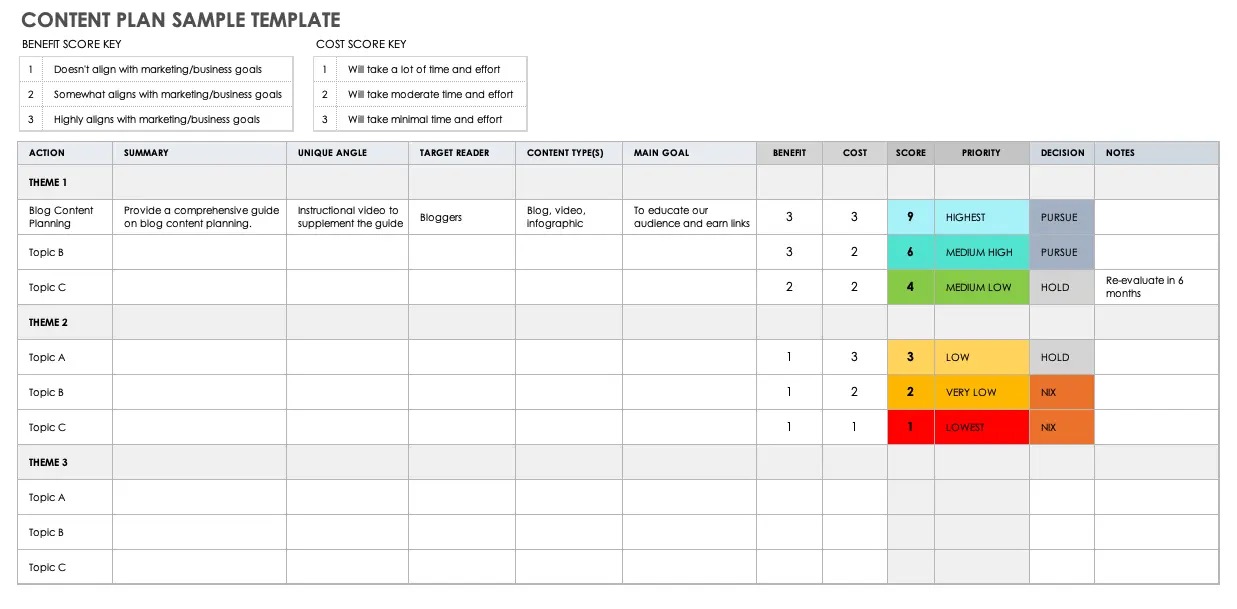
Then, the service provider creates content —which could be in the form of a blog post, an infographic, or a video— that captures the audience’s attention. All the while, paying attention to optimizing the content for search engines.
4. Link Building
Link-building services involve obtaining backlinks from trustworthy sources to improve a website’s credibility and search engine ranking.
Providers of white label link-building services assist in identifying suitable websites for obtaining valuable backlinks and arranging guest posting opportunities for your client’s website. They can also assist in listing your client’s website on relevant online directories to increase visibility on search engine results pages.
5. SEO Reports
SEO reports offer valuable information on the effectiveness of SEO tactics, indicating what is successful and what needs improvement. These reports contain a plethora of data that can assist in enhancing your clients’ online visibility. For example, you will be able to identify which online platforms are effectively directing traffic to your clients’ website.
White label SEO reports usually consist of different metrics such as traffic origins, keyword positions, backlink credibility, user engagement, and conversion rates.
Benefits of Using White Label SEO Services
White-label SEO services offer numerous advantages for agencies seeking to enhance their services and expand their business. Some of these advantages include:
Diversify service offerings
Agencies can broaden their range of services by including highly sought-after SEO services. By utilizing white label SEO services, agencies can still provide comprehensive digital marketing solutions to clients, earning their trust to manage all their online marketing needs.
Cost-efficiency
Setting up an in-house SEO team requires a substantial investment in recruitment, training, tools, and salaries. White label SEO services help eliminate these extra costs, as the service provider likely has the necessary infrastructure and expertise already in place.
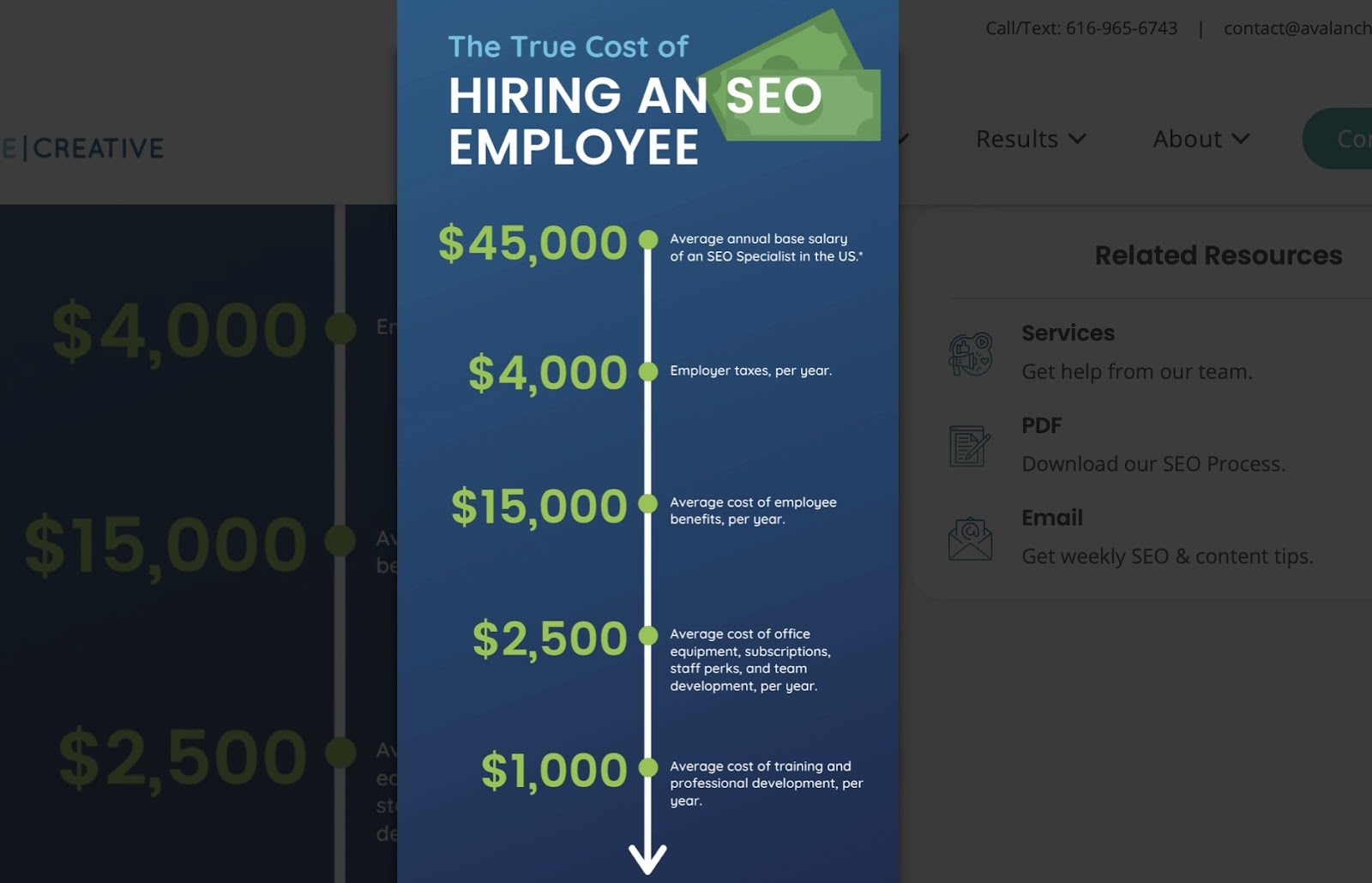
Focus on core strengths
Outsourcing SEO to a white-label provider allows agencies to concentrate on their core strengths, whether it’s web design, PPC, social media, or another aspect of digital marketing. This ensures that agencies can maintain delivering high-quality services in their area of expertise while also meeting clients’ SEO requirements.
Access to specialized knowledge
Finally, white label SEO providers are specialists in their field. This means that you can benefit from their expertise, tools, and processes— which are often at the cutting edge of SEO best practices. Such access ensures that your clients receive high-quality services that can genuinely improve their online visibility and ranking.
How to Choose a Good White Label SEO Provider
There are many white label SEO providers available, and we will look at some examples soon. However, before we do that, let’s discuss some important factors to consider when selecting one for your agency.
Track Record and Experience
Look for an SEO provider that has a proven track record of success. The experience they have in the industry can be a good indicator of their ability to deliver top-notch results. You’d be able to discover this by checking their portfolio. That’s something that the SEO provider would typically showcase on their website if they have one– as they should (if it’s an agency).
For example, SEO service provider, Boostabilty, has a website that showcases their expertise. The home page of this site also has testimonials from satisfied clients.
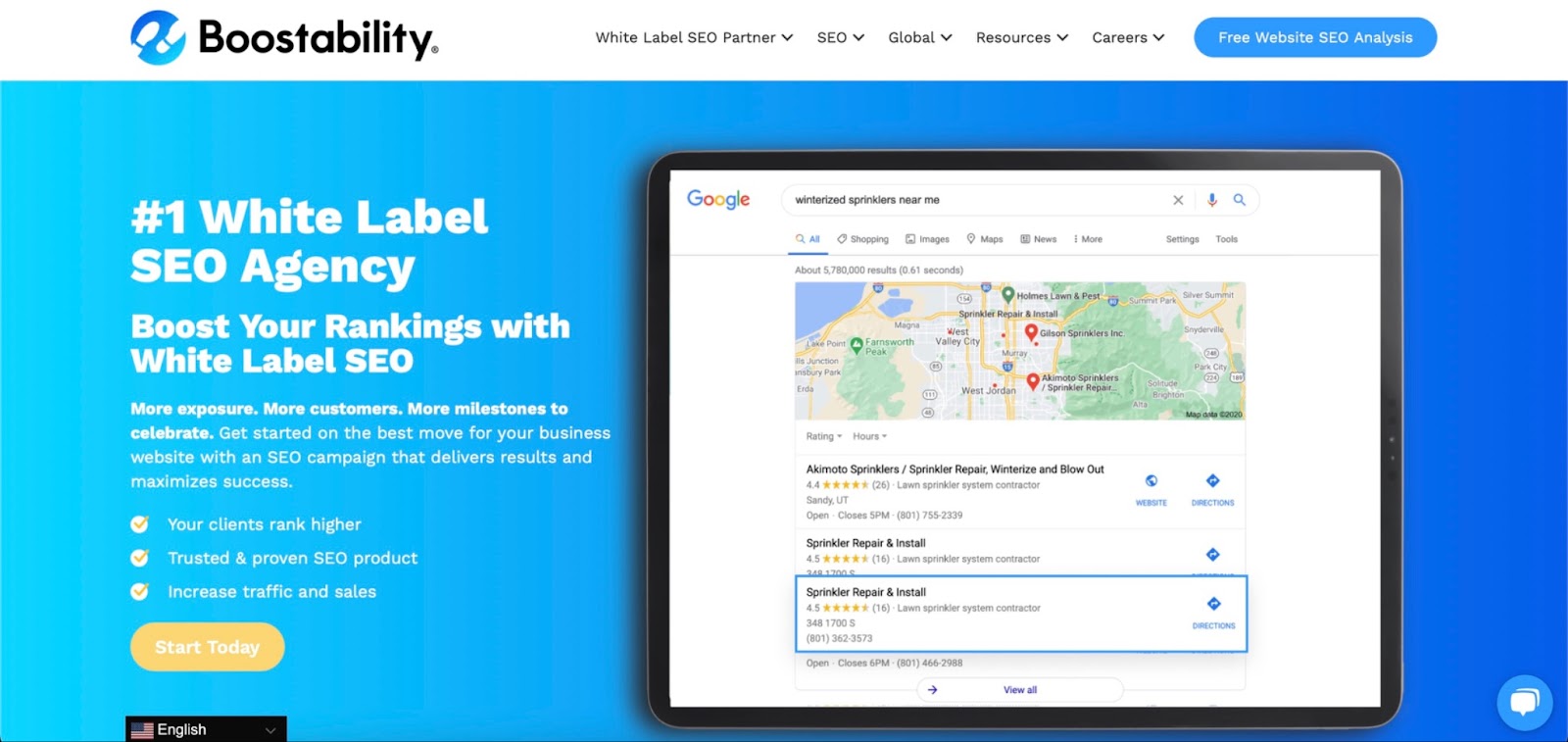
For freelancers, it’s important to have a strong portfolio showcased on professional platforms such as LinkedIn or on a landing page created using tools like Leadpage, Unbounce, or similar alternatives. The key is to be able to see evidence of their skills and expertise.
Client reviews and testimonials are also valuable indicators to consider, particularly on third-party platforms like G2, Capterra, or TrustPilot for agencies, and Upwork, LinkedIn, or Fiverr for freelancers. Checking Google business profiles can also provide helpful insights.
Transparency and Reporting
A reliable white label SEO provider will openly share their techniques and approaches. For example, if they are utilizing any AI tools, they should inform you about it.
They should also offer frequent, thorough reports that go beyond just showing rankings and traffic numbers. These reports should provide insights into their actions and reasoning, building trust with you and keeping your clients updated on their campaigns’ progress.
It’s important that your provider is responsive and ready to respond to any questions or feedback from your clients. They should have effective communication channels and a support system in place to help you whenever necessary.
SEO Service Quality
It is important to make sure that the company you work with uses ethical SEO methods that follow search engine rules. Ideally, their white label services should include everything related to SEO, such as optimizing on-page content, creating content, building links, and handling technical SEO.
Furthermore, your SEO provider should offer customizable white label SEO packages that can be adjusted to meet your clients’ specific needs. They should be adaptable and open to changing their tactics when necessary.
Cost Structure
Lastly, the pricing offered by your provider should be competitive. You should receive good quality services for the amount you invest. It is ideal if the pricing structure allows you to add a markup to their services and generate a profit.
Examples of White Label SEO Providers
Looking ahead, here are some reputable white label SEO providers that you should consider:
Marketing Miner
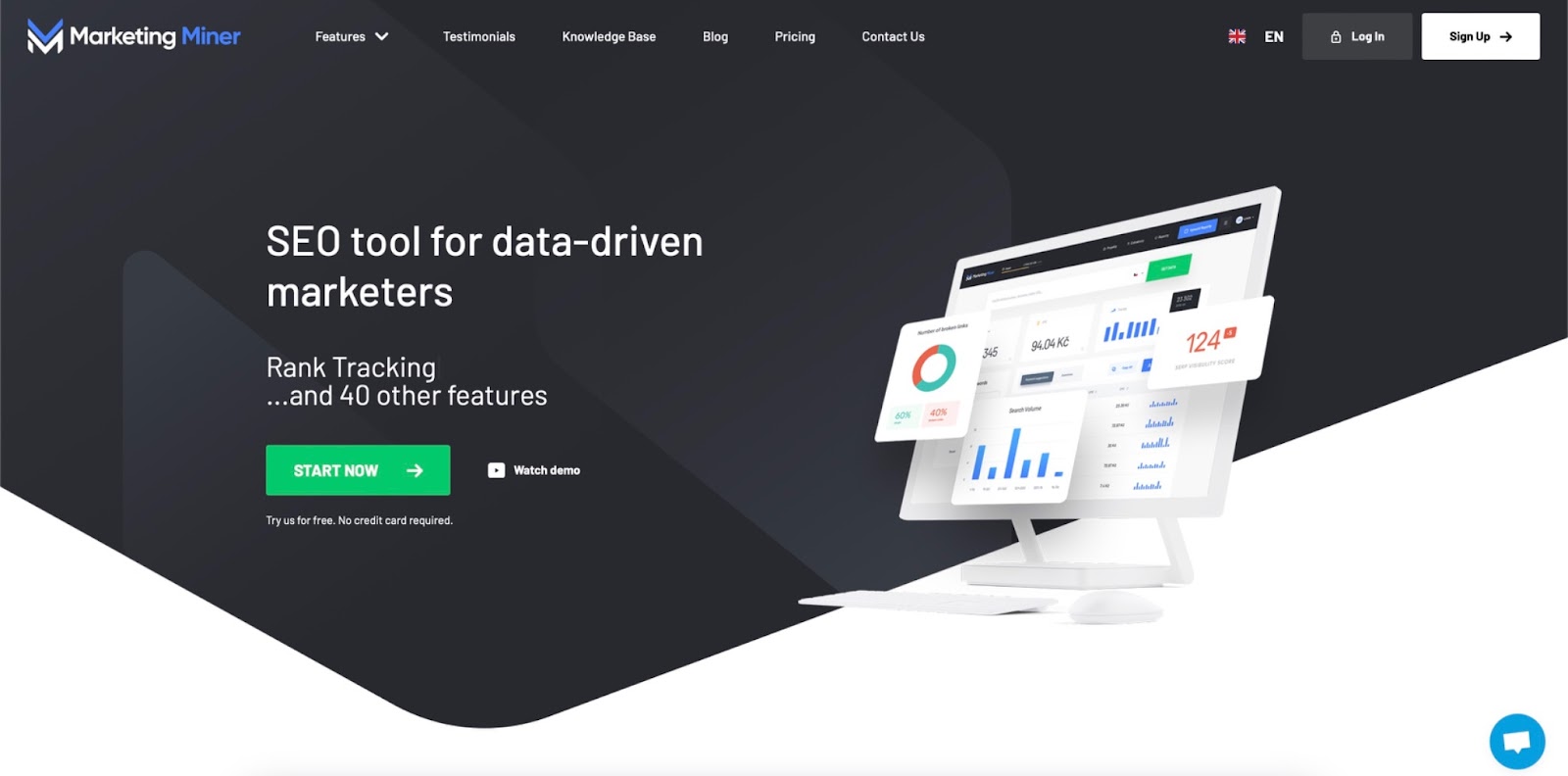
Marketing Miner is an excellent white-label solution that offers a range of features such as keyword research, SEO audits, rank tracking, and competitor analysis.
Marketing Miner can enhance your ability to analyze and report on SEO in bulk. For example, the Export feature in the rank tracking section allows users to easily integrate their rank tracking data with Looker Studio (formerly Google Data Studio).
SEO Reseller
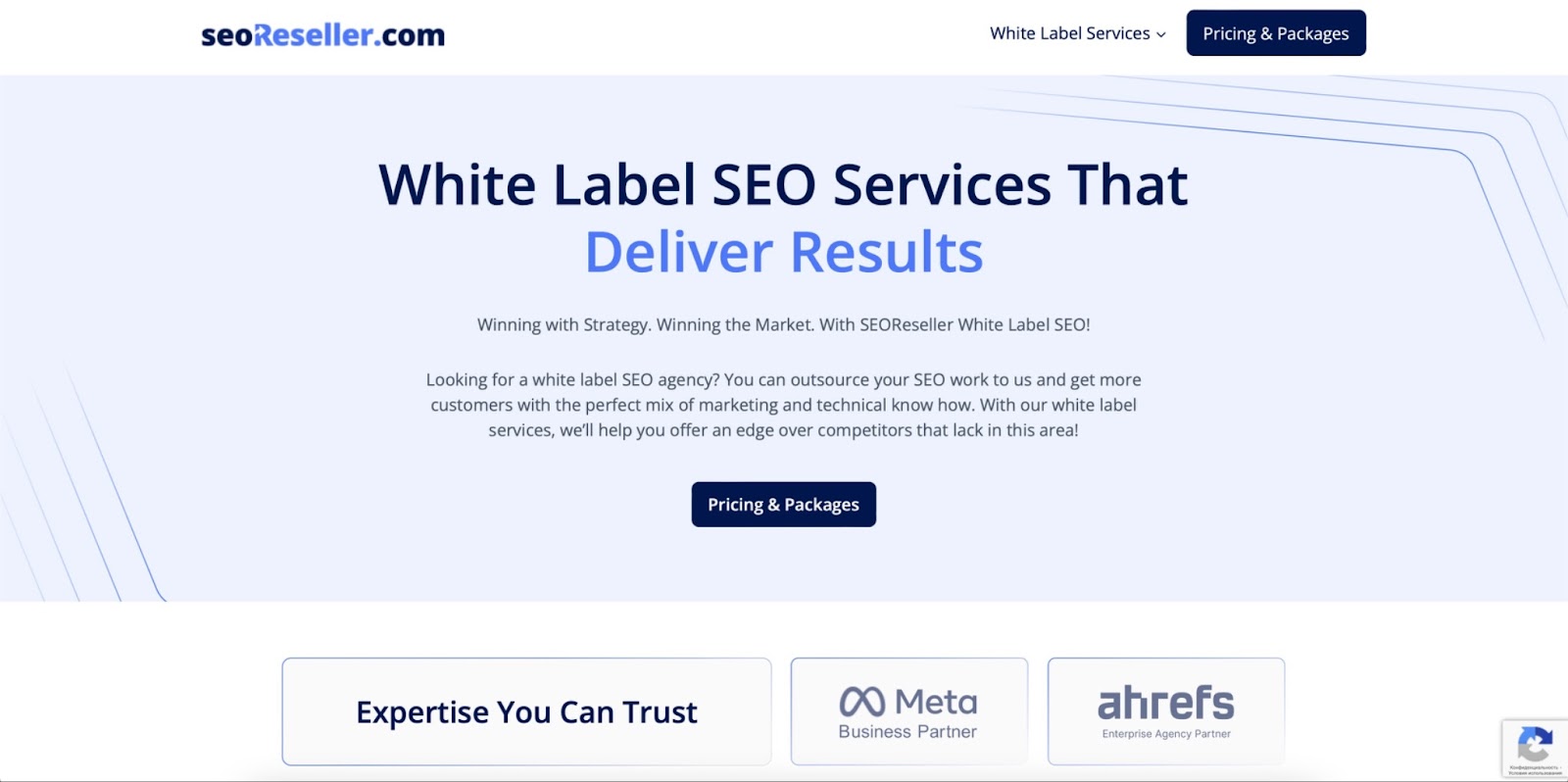
SEO Reseller is a white label agency that delivers various SEO services like link building, content optimization, and technical SEO.
They provide different packages where you can collaborate with a team of professionals including digital marketers, writers, or editors who work a set number of hours per month. Here’s a breakdown of these packages:
- SEO Plus – includes 30 hours of work monthly
- SEO Premium – provides up to 40 hours of work monthly
- SEO Prime – offers up to 50 hours weekly
SEO Reseller also offers consulting services for SEO audits, plans, reports, and expert advice. You can request a free quote on their website if you’re interested in working with them.
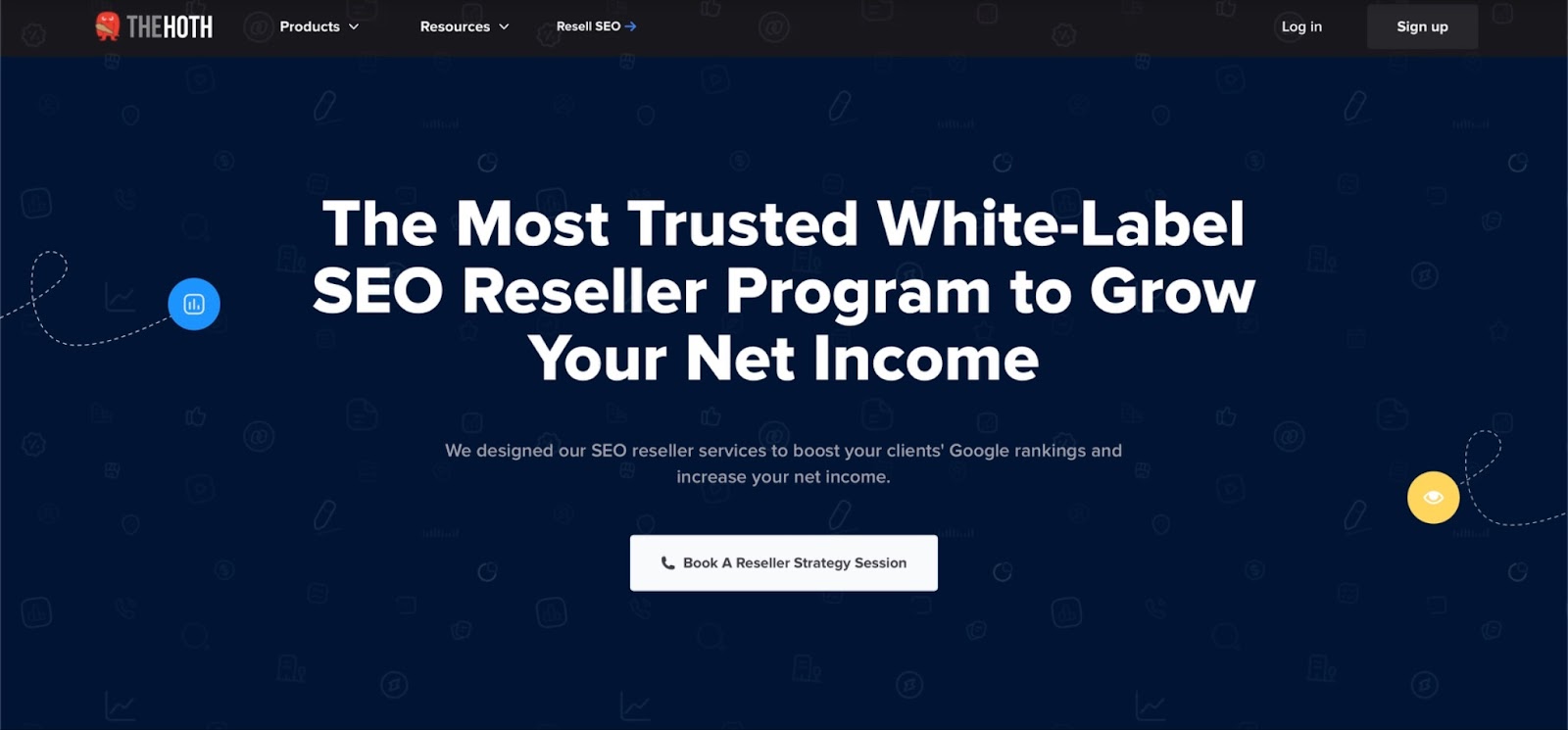
The HOTH is recognized for its high-quality backlinks and optimized content services. They offer a managed SEO service where clients are paired with a dedicated Campaign Manager to implement a monthly strategy aimed at boosting traffic and rankings. The HOTH also has a specialized white-label SEO reseller program available.
The HOTH caters to both individual businesses seeking SEO services and SEO agencies interested in reselling their offerings. They customize prices and services based on your budget.
Conclusion
White-label SEO services enable you to provide high-quality services to your clients without spending too much money. It is also a great way for a marketing agency to save time and resources.
Marketing agencies can subcontract SEO tasks such as creating content, building links, optimizing on-site and off-site SEO, conducting keyword research, and generating SEO reports. The specific services offered will vary based on the unique requirements of your clients. When selecting a white-label partner, it is important to consider factors such as their past performance, level of expertise, service quality, and pricing.
The post White Label Search Engine appeared first on Web Marketing Solutions.
]]>The post Best CPA Networks: The Top 12 Powerhouses in Performance Marketing appeared first on Web Marketing Solutions.
]]>1. MaxBounty
MaxBounty is a premier CPA (Cost Per Action) network, renowned for its diverse range of offers, advanced tracking systems, and personalized support. This network caters to both beginners and experienced marketers, providing an ideal platform to maximize campaign success.
Key Features
MaxBounty stands out due to its variety of campaigns, advanced tracking system, and dedicated account managers.
- Variety of Campaigns: Includes digital products, physical goods, and service offers.
- Advanced Tracking System: Real-time reporting, detailed analytics, and custom tracking options.
- Dedicated Account Managers: Personalized support, strategic advice, and quick issue resolution.
Pricing
MaxBounty offers competitive commission rates and frequent payout options to ensure timely compensation for its users.
- Commission Rate: Varies by offer, typically from $1 to $70 per action.
- Payout Frequency: Weekly payments with a minimum payout of $50.
- Payment Methods: Includes PayPal, check, wire transfer, and other options.
Performance
MaxBounty is known for its high conversion rates and extensive range of offers, making it a top choice in the CPA network landscape.
- User-Friendly Platform: Easy navigation and intuitive interface.
- Extensive Offer Range: Diverse selection of campaigns that cater to various niches.
- Proactive Support Team: Dedicated account managers and support staff that enhance the user experience and campaign success.
2. ClickBooth
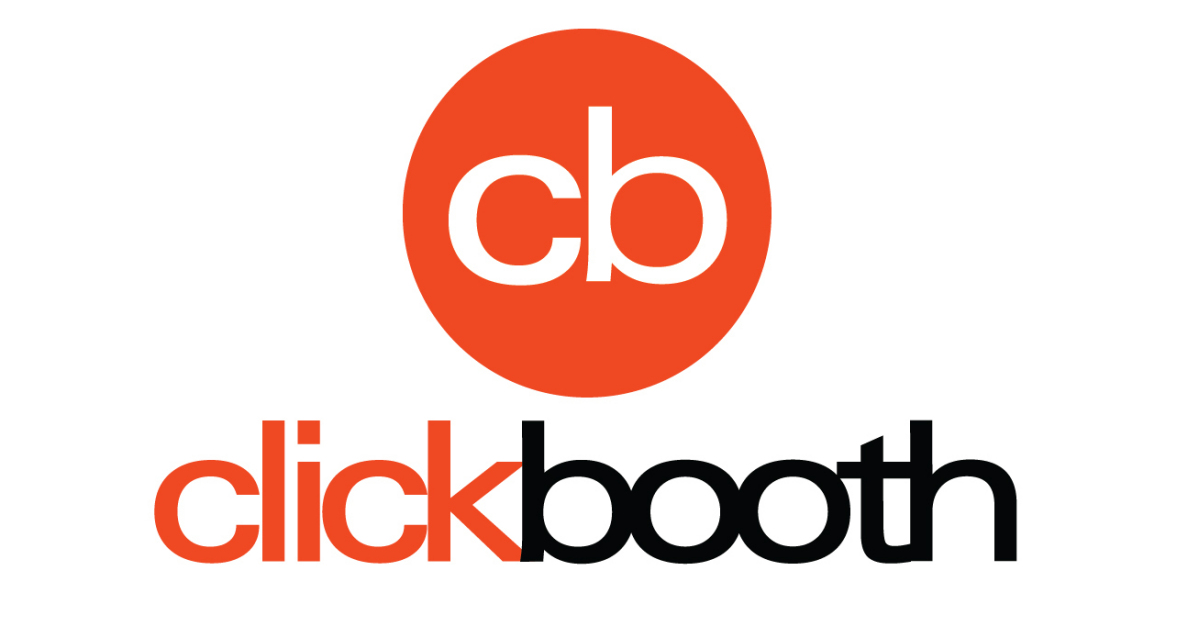
ClickBooth is renowned as an innovator in the affiliate marketing industry, providing top-tier technology and robust security measures. This network is ideal for advertisers seeking to connect with high-performing affiliates and for affiliates looking for reliable and lucrative offers.
Key Features
ClickBooth stands out due to its exclusive technology, robust security, and creative flexibility.
- Exclusive Technology: Utilizes proprietary software to connect advertisers with top-performing affiliates.
- Robust Security: Implements strict measures to prevent fraud and ensure quality traffic.
- Creative Flexibility: Allows customization of creatives to better suit specific campaigns.
Pricing
ClickBooth offers competitive commission rates and frequent payout options, ensuring timely compensation for its users.
- Commission Rate: Generally ranges from $5 to $100 per action, depending on the complexity and conversion likelihood.
- Payout Frequency: Bi-weekly, with a minimum payout threshold of $100.
- Payment Methods: Includes various options to facilitate smooth transactions.
Performance
ClickBooth is a favorite among marketers due to its commitment to innovation and quality, often leading the industry in technological advancements.
- Innovation Leader: Frequently introduces new technologies to enhance affiliate marketing efficiency.
- High-Quality Traffic: Ensures traffic quality through robust security measures.
- Creative Optimization: Offers flexibility in creatives to maximize campaign success.
3. PeerFly

PeerFly is a well-regarded CPA network known for its extensive network of offers, custom tracking platform, and no monthly fees. This network provides affiliates with a straightforward and effective platform to maximize their earnings.
Key Features
PeerFly stands out due to its extensive network, custom tracking platform, and absence of monthly fees.
- Extensive Network: Access to over 8,000 active offers in various niches.
- Custom Tracking Platform: Tailored platform designed for better data accuracy and usability.
- No Monthly Fees: Charges only on a per-action basis without any hidden fees.
Pricing
PeerFly offers competitive commission rates and multiple payout frequency options to suit affiliates’ needs.
- Commission Rate: Typically between $1.50 and $150 per action, highly variable across different offers.
- Payout Frequency: Net-30, Net-15, and weekly payments available.
- Payment Methods: Includes various options to facilitate smooth transactions.
Performance
PeerFly is celebrated for its rapid growth and favorable publisher terms, making it a top choice for affiliates who prefer a straightforward, effective network.
- Rapid Growth: Known for its quick expansion and increasing market presence.
- Favorable Publisher Terms: Attractive terms that benefit publishers significantly.
- Straightforward Network: User-friendly and efficient, ideal for maximizing affiliate earnings.
4. A4D

A4D is a prominent CPA network known for its strong presence across diverse verticals, performance optimization, and global reach. It caters to serious marketers by providing scalable solutions and reliable high-quality traffic management.
Key Features
A4D stands out due to its diverse verticals, performance optimization, and global reach.
- Diverse Verticals: Strong presence in both digital and physical product spaces.
- Performance Optimization: Proactive optimization advice from experienced account managers.
- Global Reach: Supports campaigns in many different countries.
Pricing
A4D offers a wide range of commission rates and a straightforward monthly payout frequency to suit various marketing needs.
- Commission Rate: Ranges from $2 to $200 per CPA, depending on the vertical.
- Payout Frequency: Payments are issued on a monthly basis.
- Payment Methods: Includes various options to facilitate smooth transactions.
Performance
A4D is known for its reliability and performance in managing high-quality traffic and providing scalable solutions for serious marketers.
- High-Quality Traffic: Ensures reliable and effective traffic management.
- Scalable Solutions: Provides tools and support for growing marketing campaigns.
- Reliable Performance: Consistent and dependable results for marketers.
5. Admitad
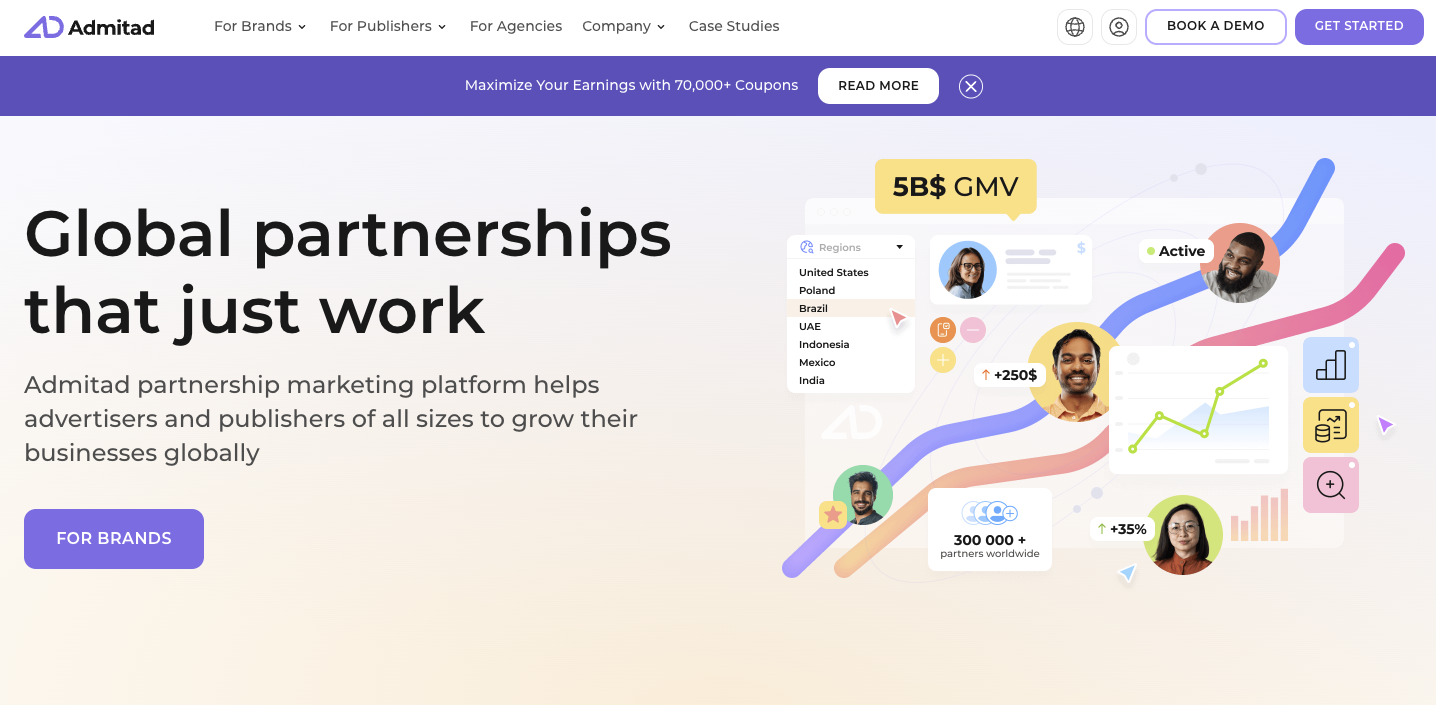
Admitad is a leading CPA network known for its wide international coverage, innovative tools, and flexible integration. It provides an ideal platform for advertisers aiming to expand their global footprint with robust support and advanced tools.
Key Features
Admitad stands out due to its wide international coverage, innovative tools, and flexible integration.
- Wide International Coverage: Supports campaigns in Europe, Asia, and the Americas.
- Innovative Tools: Offers tools like Admitad Teleport to improve ad performance.
- Flexible Integration: Easy to integrate with multiple platforms and services.
Pricing
Admitad provides competitive commission rates and flexible payment terms to meet the needs of various marketers.
- Commission Rate: Generally from $0.50 to $150 per action.
- Payout Frequency: Flexible payment terms, including weekly payouts.
- Payment Methods: Includes various options to facilitate smooth transactions.
Performance
Admitad excels with its vast range of tools and geographical reach, making it ideal for advertisers looking to expand their global footprint.
- Vast Range of Tools: Offers numerous tools to enhance ad performance and campaign management.
- Geographical Reach: Extensive support across Europe, Asia, and the Americas.
- Global Expansion: Ideal for advertisers aiming to grow their presence worldwide.
6. CJ Affiliate (formerly Commission Junction)
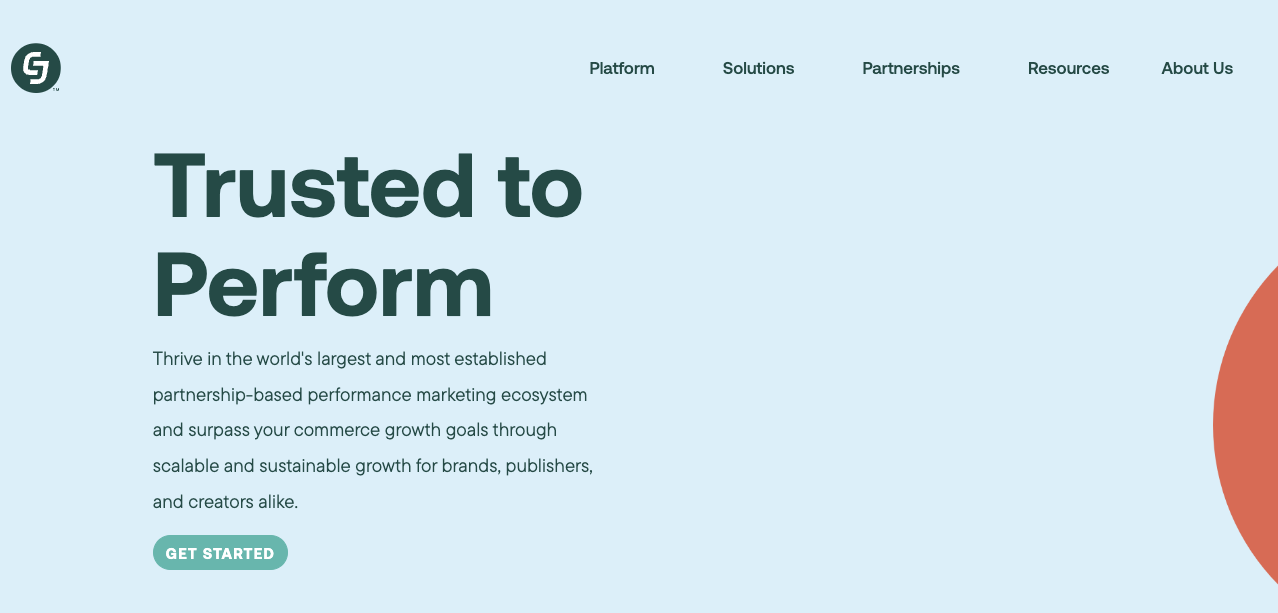
CJ Affiliate is a highly respected CPA network known for its extensive affiliate network, advanced deep linking options, and real-time reporting. It provides a robust platform for both seasoned marketers and newcomers to manage and optimize their affiliate campaigns effectively.
Key Features
CJ Affiliate stands out due to its broad affiliate network, deep linking options, and real-time reporting.
- Broad Affiliate Network: Access to a wide variety of advertisers across multiple sectors.
- Deep Linking Options: Advanced options for linking directly to products.
- Real-Time Reporting: Immediate access to campaign performance data.
Pricing
CJ Affiliate offers a flexible commission structure and convenient payout options to cater to various marketers’ needs.
- Commission Rate: Varies widely with offers, ranging from a few dollars to several hundred per action.
- Payout Frequency: Monthly payments with a minimum threshold of $50 for direct deposit and $100 for checks.
- Payment Methods: Includes various options to facilitate smooth transactions.
Performance
CJ Affiliate is revered for its extensive network and robust tools that facilitate effective affiliate management, making it a favorite among both seasoned marketers and those new to the field.
- Extensive Network: Large pool of advertisers across various sectors.
- Robust Tools: Advanced features for efficient affiliate management.
- Effective Campaign Management: Tools and support that enhance campaign success.
7. Rakuten Advertising (formerly Rakuten Marketing)
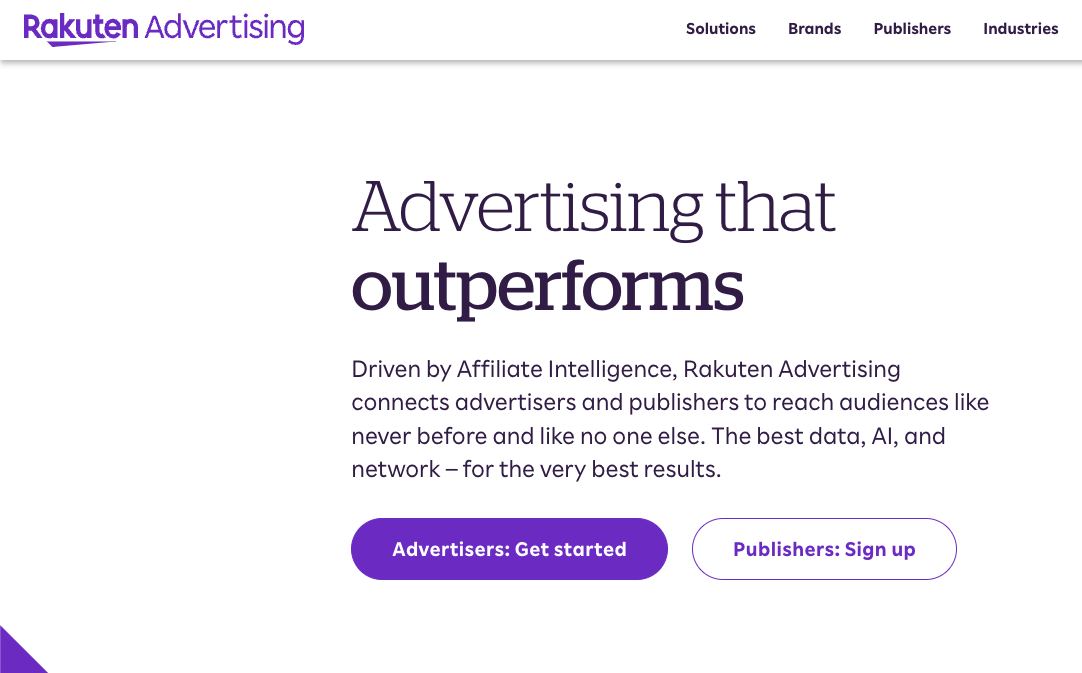
Rakuten Advertising is a leading CPA network known for its international reach, innovative technology, and comprehensive marketing insights. It supports affiliates and advertisers with advanced tools and strategies to maximize their campaign effectiveness.
Key Features
Rakuten Advertising stands out due to its international reach, innovative technology, and deep market insights.
- International Reach: Strong presence in the global market with diverse affiliate programs.
- Innovative Technology: Provides cutting-edge tools for tracking and optimizing campaigns.
- Marketing Insights: Offers deep market insights to help affiliates and advertisers strategize effectively.
Pricing
Rakuten Advertising offers a flexible commission structure and reliable monthly payouts to suit the needs of its users.
- Commission Rate: Rates are highly variable, typically between $1 and $200 depending on the advertiser and type of product.
- Payout Frequency: Payments are made monthly.
- Payment Methods: Includes various options to facilitate smooth transactions.
Performance
Rakuten Advertising is known for its strategic approach to affiliate marketing and extensive analytics, helping affiliates and advertisers achieve significant returns on their investments.
- Strategic Approach: Focuses on strategic planning to enhance affiliate marketing outcomes.
- Extensive Analytics: Provides comprehensive data analysis to optimize campaigns.
- Significant Returns: Helps affiliates and advertisers achieve high returns on their investments.
8. Impact
Impact is a distinguished CPA network recognized for its advanced automation tools, flexible partnership models, and intuitive interface. It caters to affiliates who prioritize transparency and efficiency in their marketing efforts through innovative technology.
Key Features
Impact stands out due to its robust automation tools, flexible partnership models, and user-friendly platform.
- Automation Tools: Robust technology for managing partnerships and tracking performance.
- Flexible Models: Supports a variety of partnership models beyond traditional affiliate systems.
- Intuitive Interface: User-friendly platform designed to streamline campaign management.
Pricing
Impact offers variable commission rates and standard payment terms to accommodate diverse campaign needs.
- Commission Rate: Commission rates vary based on campaign specifics and advertiser settings.
- Payout Frequency: Net-30 payment terms.
- Payment Methods: Includes various options to facilitate smooth transactions.
Performance
Impact’s emphasis on technology and innovation makes it a standout choice for affiliates who value transparency and efficiency in their marketing efforts.
- Technology Focus: Emphasizes advanced technology to enhance performance tracking and management.
- Innovation: Continuously introduces new features to improve efficiency.
- Transparency: Provides clear and detailed insights into campaign performance.
9. Avangate Affiliate Network
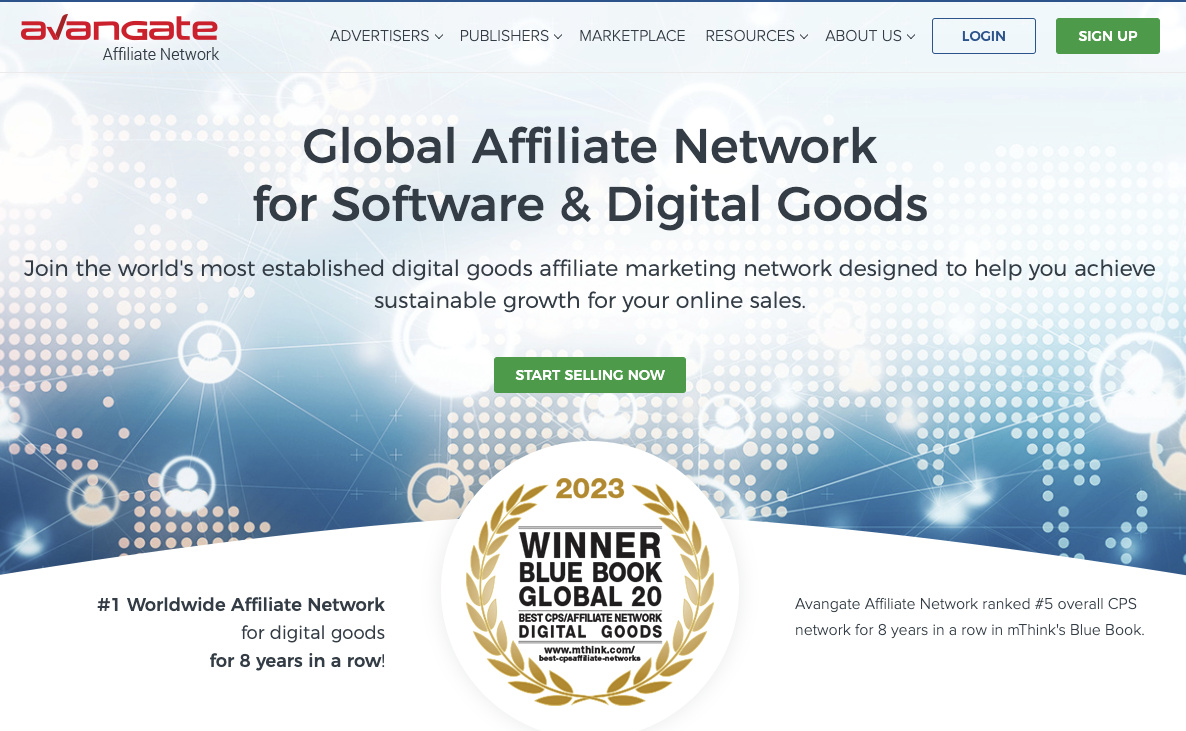
Avangate Affiliate Network is a premier CPA network specializing in software and digital goods. Its global reach and advanced analytics make it a top choice for affiliates in these niches, offering lucrative opportunities and robust support.
Key Features
Avangate Affiliate Network stands out due to its focus on software, global reach, and advanced analytics.
- Focus on Software: Specializes in software and digital goods, making it ideal for relevant niches.
- Global Reach: Supports multiple currencies and languages, facilitating international transactions.
- Advanced Analytics: Offers detailed analytics to help affiliates track and optimize their efforts.
Pricing
Avangate provides competitive commission rates and convenient monthly payouts to meet the needs of affiliates.
- Commission Rate: Typically ranges from 20% to 50% for software products.
- Payout Frequency: Monthly payouts, with a minimum threshold of $100.
- Payment Methods: Includes various options to facilitate smooth transactions.
Performance
Avangate is highly regarded in the software industry, providing affiliates with lucrative opportunities in a niche market that continues to grow rapidly.
- Software Industry Leader: Highly regarded within the software sector.
- Lucrative Opportunities: Offers significant earning potential for affiliates.
- Rapid Market Growth: Continues to expand in the rapidly growing software market.
10. ShareASale
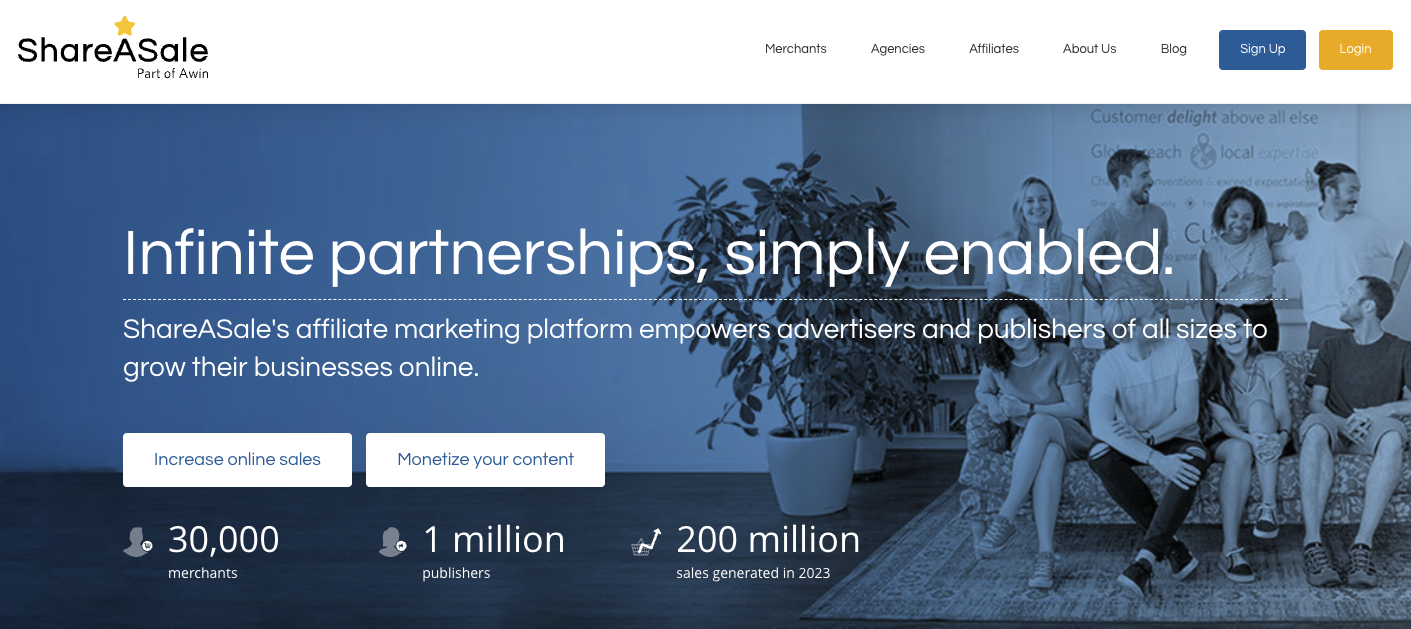
ShareASale is a well-established CPA network known for its extensive merchant base, real-time tracking, and innovative affiliate tools. It provides a reliable and user-friendly platform for affiliates to partner with a wide range of merchants across various industries.
Key Features
ShareASale stands out due to its extensive merchant base, precise tracking technology, and innovative affiliate tools.
- Extensive Merchant Base: Features a wide range of merchants across various industries.
- Real-Time Tracking: Offers precise tracking technology for accurate campaign measurement.
- Innovative Affiliate Tools: Provides tools such as banners, links, and real-time reporting.
Pricing
ShareASale offers competitive commission rates and convenient monthly payouts to suit the needs of affiliates.
- Commission Rate: Varies by merchant, with some offering up to 50% commissions.
- Payout Frequency: Monthly payments, with a minimum payout of $50.
- Payment Methods: Includes various options to facilitate smooth transactions.
Performance
ShareASale stands out for its reliability, user-friendly interface, and comprehensive support resources. It’s a great platform for affiliates looking to partner with a wide range of merchants.
- Reliability: Known for consistent and dependable performance.
- User-Friendly Interface: Easy to navigate and manage campaigns.
- Comprehensive Support Resources: Provides extensive support and resources for affiliates.
11. Convert2Media
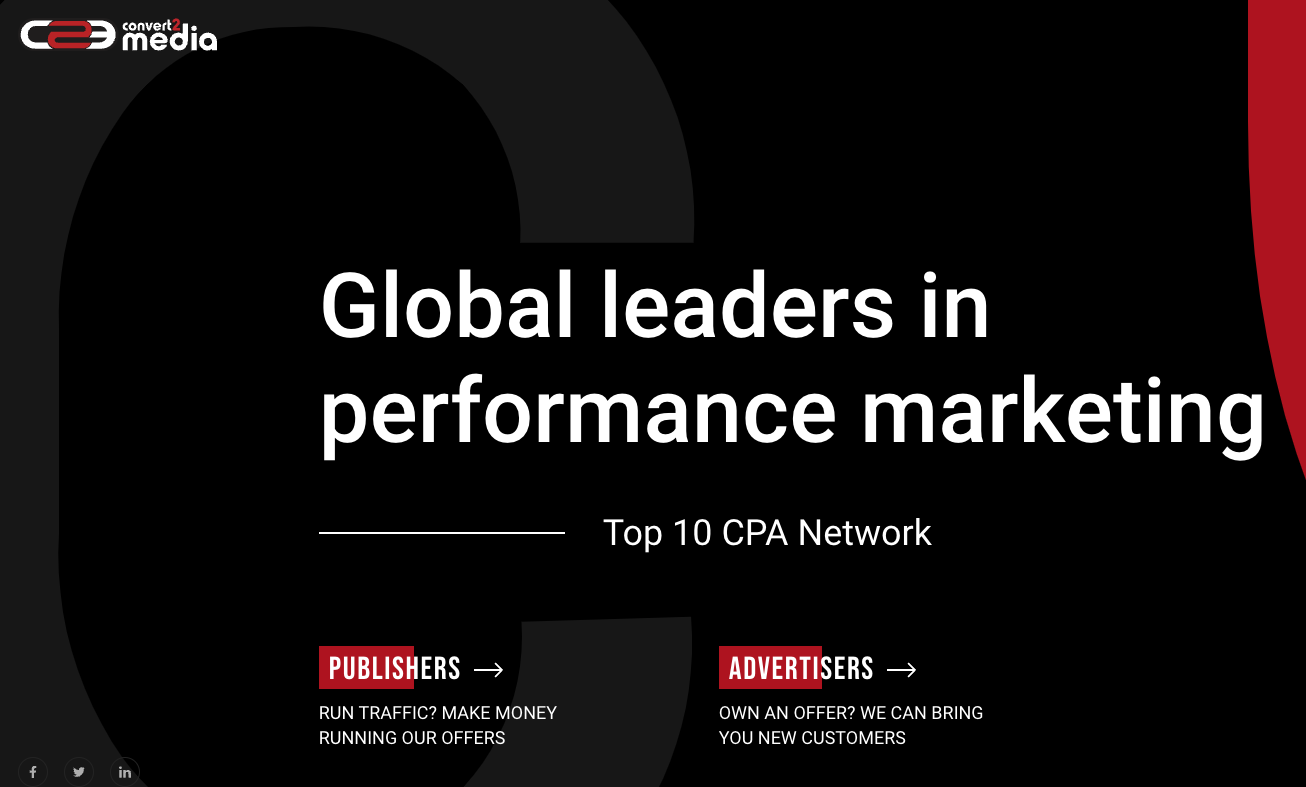
Convert2Media is a leading CPA network recognized for its customized marketing solutions, robust affiliate support, and advanced fraud prevention systems. It caters to affiliates who prioritize security and performance, offering tailored campaigns and extensive support.
Key Features
Convert2Media stands out due to its custom campaigns, robust affiliate support, and fraud prevention measures.
- Custom Campaigns: Offers customized marketing solutions tailored to specific advertiser needs.
- Robust Affiliate Support: Provides extensive support through dedicated account managers.
- Fraud Prevention: Advanced systems in place to detect and prevent fraudulent activities.
Pricing
Convert2Media offers flexible commission rates and frequent payouts to meet the needs of its affiliates.
- Commission Rate: Typically ranges from $1 to $150 per action, varying significantly based on the campaign and vertical.
- Payout Frequency: Offers weekly payouts, with a minimum threshold of $100, facilitating quicker access to earnings.
- Payment Methods: Includes various options to facilitate smooth transactions.
Performance
Convert2Media is known for its strong focus on high-quality traffic and effective conversions, making it a favorite for affiliates who prioritize security and performance in their marketing strategies.
- High-Quality Traffic: Ensures that affiliates receive top-tier traffic for their campaigns.
- Effective Conversions: Focuses on optimizing conversion rates for better results.
- Security: Emphasizes advanced fraud prevention to maintain campaign integrity.
12. FlexOffers
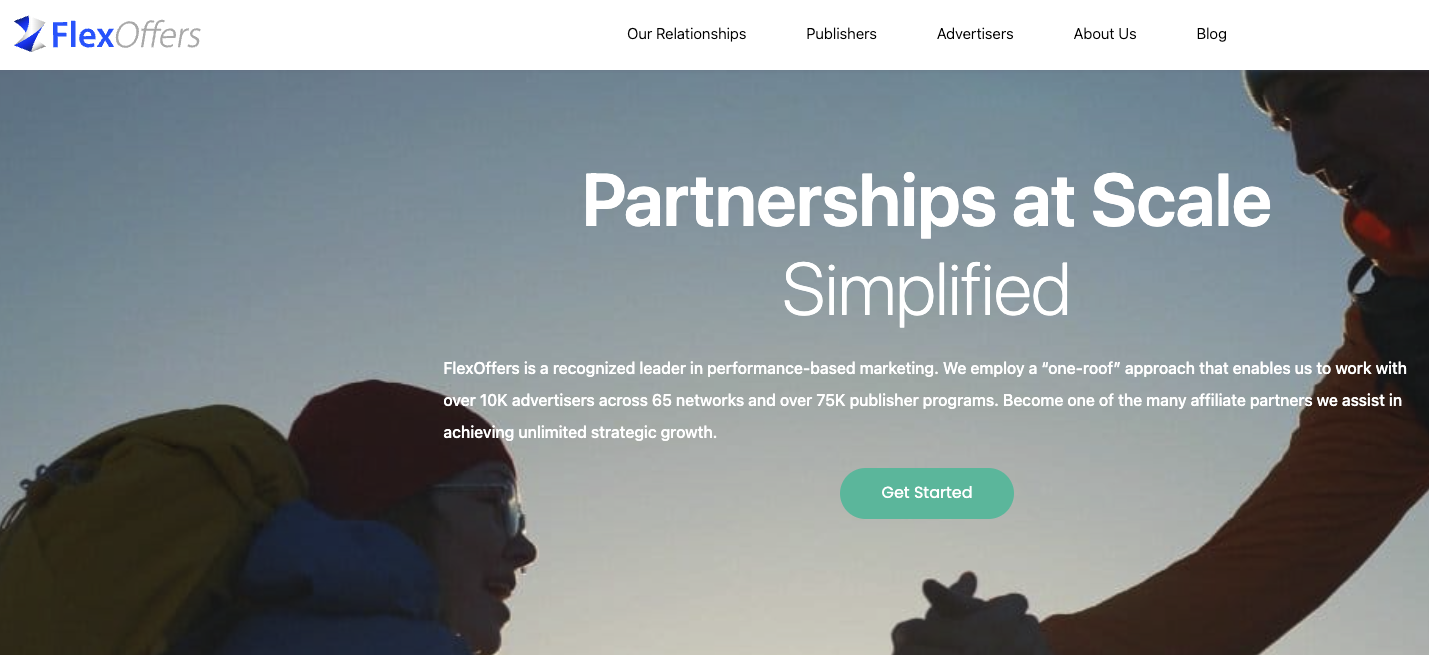
FlexOffers is a versatile CPA network known for its wide range of advertisers, enhanced data delivery, and affiliate rewards program. It provides an ideal platform for both novice and experienced marketers, offering diverse opportunities and consistent support.
Key Features
FlexOffers stands out due to its wide range of advertisers, robust reporting tools, and dynamic rewards system.
- Wide Range of Advertisers: Features thousands of affiliate programs across various industries.
- Enhanced Data Delivery: Provides robust reporting tools and real-time data for better decision-making.
- Affiliate Rewards Program: Offers bonuses and incentives based on performance.
Pricing
FlexOffers provides flexible commission rates and convenient monthly payouts to suit the needs of its affiliates.
- Commission Rate: Varies widely; commissions can go up to 50% or more, particularly in lucrative niches.
- Payout Frequency: Monthly payments, with a minimum payout of $50 through PayPal and $1000 for wire transfers.
- Payment Methods: Includes various options to facilitate smooth transactions.
Performance
FlexOffers stands out due to its vast affiliate options and dynamic rewards system, catering to both novice and experienced marketers looking for diverse opportunities and consistent support.
- Vast Affiliate Options: Provides a wide array of programs to choose from.
- Dynamic Rewards System: Encourages performance with bonuses and incentives.
- Consistent Support: Offers reliable support to ensure successful campaign management.
Conclusion
By aligning yourself with one of these top CPA networks, you can significantly boost your performance marketing efforts. Each network offers distinct advantages and caters to different types of marketers, so choose the best CPA network that fits your business needs and start optimizing your affiliate marketing strategy today!
FAQ
A CPA network acts as an intermediary between advertisers who want to generate actions (like sales or registrations) and publishers who can drive those actions through their websites or other marketing efforts.
– Reputation: Look for networks with positive reviews and proven track records.
– Offer Selection: Consider networks that have offers relevant to your niche.
– Payout Terms: Evaluate the commission rates and payout frequencies.
Payout Terms: Evaluate the commission rates and payout frequencies.
Yes, because you only pay for results, CPA networks can be incredibly cost-effective. They reduce the risk of advertising spend without returns.
– Select the Right Offers: Choose offers that align well with your audience.
– Optimize Your Campaigns: Test different strategies and utilize the tools provided by the network to optimize your campaigns.
– Stay Informed: Keep up with new offers and changes within the network.
The post Best CPA Networks: The Top 12 Powerhouses in Performance Marketing appeared first on Web Marketing Solutions.
]]>The post A Complete Guide on How to Send a Video That Is Too Large appeared first on Web Marketing Solutions.
]]>Understanding Video File Sizes
One major challenge in video sharing is the handling of sizable files. Videos, particularly those with high-definition or lengthy content, often surpass file size restrictions set by numerous email services and social media platforms.
What Influences Video File Size?
The size of a video file is determined by various factors, and having knowledge about them can aid in efficient management and optimization of your video content.
- Resolution: The file size is significantly increased by higher resolutions such as 1080p or 4K.
- Duration: The size is directly influenced by the length of the video.
- Bitrate: Better quality can be achieved with a higher bitrate, although at the expense of larger file sizes.
- Codec: Video files are compressed in various ways by different encoding algorithms. One such example is H.264, which offers greater efficiency compared to certain outdated codecs.
Average Video File Sizes
In the table below, you can see how file sizes for videos vary according to their resolutions and frame rates when recorded for one hour. The data shows average values.
| Resolution | Frame Rate | Average File Size per Hour |
| 720p | 30fps | Approximately 0.9 GB |
| 1080p | 30fps | Roughly 1.5 GB |
| 4K | 30fps | Around 7.2 GB |
Benefits of Compressing Videos

Compressing your videos can drastically shrink the file size, simplifying its transfer over email or social media. This method guarantees more convenient and controllable accessibility without sacrificing video quality. Consistent compression of shared material allows for seamless workflow optimization while enriching viewer enjoyment potential.
Faster Uploads and Downloads
Video compression offers a notable advantage of shrinking the file size, which results in quicker uploading and downloading rates. This can be highly advantageous when it comes to sharing videos via email or posting them on websites.
- Efficiency: Saving time during the upload and download process, smaller files transfer at a faster pace.
- User Experience: Accelerated downloads elevate the viewer’s encounter by minimizing waiting periods and probable irritation.
- Bandwidth Management: Managing bandwidth usage is especially crucial for users with restricted internet speeds or data caps, and reducing file sizes can aid in achieving this goal.
Reduced Storage Space
When you compress videos, you can save significant storage space on your devices and servers. As a result, it becomes possible to store more content, an important consideration for individual users as well as businesses that may face limited resources for storage needs.
- Device Storage: Personal devices like smartphones, tablets and computers can save more space if smaller video files are used.
- Server Storage: Reducing file sizes in businesses can decrease reliance on expensive server storage solutions.
- Cloud Storage: The efficiency of using cloud storage services is enhanced when files are compressed, thereby maximizing the storage space that’s available.
Improved Compatibility
Having smaller file sizes increases the chances of compatibility with different devices and platforms, which guarantees a broader audience for your videos. Compatibility is an essential aspect of making sure that your content can be accessed and watched through various media forms.
- Cross-Platform Viewing: Videos that have been compressed can be shared and viewed more efficiently on a variety of devices, including smartphones, tablets, and computers.
- Email Attachments: To comply with attachment size restrictions set by several email services, one solution is to compress videos.
- Social Media: To prevent exceeding upload restrictions on social media platforms, it is recommended to use compressed videos for sharing content.
Cost Savings
Lowering data file sizes can decrease expenses related to storing and transferring information, particularly for corporations that manage significant amounts of video media. Being cost-effective is a crucial benefit, specifically for establishments striving to streamline their procedures.
- Data Transfer Costs: Reduced file size results in decreased data transfer needs, which cuts down expenses linked with data transfer. This is especially beneficial for businesses that frequently exchange large files.
- Storage Solutions: By compressing videos, one can decrease the requirement for expensive storage options, resulting in reduced expenses on physical or cloud-based storage.
- Operational Efficiency: Overall operational efficiency can be improved by implementing streamlined video management practices, resulting in reduced time and resources required for handling large video files.
Compressing Videos Before Sending
Compressing a video file is often the initial step in handling large files, and there are several means to do so without sacrificing quality. The following techniques can help you decrease your video’s size effectively.
Software Solutions for Compression
Numerous software solutions exist that facilitate compressing video files effectively. These tools provide diverse features and settings to ensure minimal reduction in quality while reducing the size of your videos.
- HandBrake: HandBrake is a versatile free tool that provides robust compression settings and supports various formats. Users can easily customize it by tweaking multiple parameters to strike the right balance between quality and file size.
- Adobe Premiere Pro: Premiere Pro enables industry experts to access professional-grade compression options that are highly regarded for their precision and advanced features. With extensive control over encoding settings, this software makes it feasible to achieve optimal compression without any discernible loss of quality, thereby elevating its popularity among professionals in the field.
- Final Cut Pro: Ideal for those using Mac who want to compress video files, Final Cut Pro seamlessly integrates with macOS and offers robust video editing tools along with compression features. Its intuitive interface allows effortless adjustment of settings that can be previewed instantaneously.
Steps to Compress a Video using HandBrake
If you are seeking to compress videos, HandBrake can be an ideal tool for its popularity as a free and user-friendly open-source program. To perform compression of your video using HandBrake, follow these steps:
- Download and Install HandBrake: You can access the HandBrake website, get hold of the installer and proceed with installation by adhering to guidelines. The software is compatible with Windows, macOS as well as Linux operating systems.
- Import Your Video File: Launch HandBrake and navigate to the “File” option. With its support for an extensive array of video formats, HandBrake is a flexible tool that can cater to various compression requirements.
- Choose a Preset: HandBrake offers various presets designed for different needs. For general purposes, selecting the “Web” preset can be a good starting point. Presets simplify the process by providing recommended settings for different devices and platforms.
- Adjust the Bitrate: If you need to reduce the file size further, adjust the bitrate in the “Video” tab. Lowering the bitrate will decrease the file size but may also reduce the video quality. A lower bitrate results in smaller file sizes but can affect the sharpness and clarity of the video.
- Preview the Video: Use the preview function to check the quality of your video with the new settings. This step ensures that the compressed video meets your expectations before starting the full encoding process. Previewing allows you to make adjustments as needed without having to wait for the entire encoding process to complete.
- Start Encoding: Once satisfied with the settings, click “Start Encode” to begin the compression process. HandBrake will save the compressed video file to your designated location. Depending on the length and resolution of the video, this process can take some time.
Using Cloud Services to Send Large Videos

Another effective method on how to send a video that is too large is utilizing cloud services. These platforms store your video on the internet, allowing you to share a link with your recipients without worrying about attachment size limits.
Popular Cloud Services
Several cloud services provide convenient options for storing and sharing large video files. Here are some of the most popular ones:
- Google Drive: Offers 15 GB of free storage. Google Drive integrates seamlessly with other Google services, making it a versatile choice for both personal and professional use.
- Dropbox: Starts with 2 GB of free storage with options for upgrades. Dropbox is known for its simplicity and ease of use, with various plans available for additional storage and features.
- WeTransfer: Allows sending files up to 2 GB for free without registration. WeTransfer is ideal for quick transfers and does not require the recipient to have an account, simplifying the sharing process.
How to Use Google Drive to Send a Large Video
Google Drive is a popular choice for sending large videos due to its generous free storage and easy sharing options. Here are the steps to use Google Drive for sending a large video:
- Upload Your Video File to Your Google Drive: Open Google Drive in your web browser and sign in to your account. Click on the “New” button and select “File upload” to choose the video file from your computer. Wait for the upload to complete.
- Right-Click the Video File and Select ‘Share’: Once the video is uploaded, locate it in your Google Drive. Right-click on the file and select the “Share” option from the context menu.
- Set the Sharing Permissions According to Your Needs: In the sharing settings window, you can specify who can access the video. You can enter specific email addresses or choose to create a shareable link. Adjust the permissions to either “Viewer,” “Commenter,” or “Editor,” depending on what access you want to grant.
- Copy the Link and Send It to Your Recipient: After setting the appropriate permissions, click on “Copy link.” You can then paste this link into an email, message, or any other communication tool to share it with your recipient. The recipient can access the video by clicking on the link, without needing to worry about file size limitations.
Conclusion
By following these methods, you can effectively manage how to send a video that is too large, ensuring your videos reach their intended audience without a hitch. Whether through compression or utilizing cloud services, the options available today make it easier than ever to share your large video files.
FAQ
A: Most email providers limit attachments to between 25 MB to 50 MB. Using a compression tool or a cloud service is recommended for larger files.
A: Cloud services like Google Drive or WeTransfer are excellent options for sending videos up to 500 MB for free.
A: Yes, compressing a video can reduce its quality, but modern tools like HandBrake allow you to balance quality and file size efficiently.
A: Basic accounts are usually free and sufficient for moderate use, but larger storage capacities or enhanced features might require a paid subscription. For instance, Google Drive offers 100 GB for approximately $1.99 per month.
The post A Complete Guide on How to Send a Video That Is Too Large appeared first on Web Marketing Solutions.
]]>The post Exploring Legal Avenues to Earn Money Online: Discover Your Next Income Stream! appeared first on Web Marketing Solutions.
]]>Freelance Your Skills
Freelancing remains one of the most straightforward methods to make money online legally. Platforms like Upwork, Freelancer, and Fiverr offer a marketplace where you can offer your professional services ranging from writing and graphic design to software development and marketing.
prehension.
The Essentials of Freelancing
Freelancing involves providing services to clients on a project-by-project basis. Here are the key aspects to consider:
- Platforms: Utilize platforms like Upwork, Freelancer, and Fiverr to find potential clients and projects.
- Skills: Offer services that align with your expertise and passions to ensure quality and satisfaction.
- Profile: Create a compelling profile to attract potential clients. Highlight your skills, experiences, and past projects.
Potential Earnings
Your earnings as a freelancer can vary widely based on the type of work you do and your level of expertise. Here is a breakdown of potential earnings:
| Service Type | Earnings (per hour) |
| Writing | $10 – $50 |
| Graphic Design | $20 – $80 |
| Software Development | $30 – $100 |
| Marketing | $15 – $60 |
Pro Tip
To increase your visibility and credibility on freelancing platforms:
- Complete Your Profile: Include a professional photo, a detailed bio, and examples of your work.
- Network: Connect with other freelancers and potential clients on social media and industry forums.
- Stay Active: Regularly update your profile and apply for new projects.
- Offer Trial Projects: Consider offering small trial projects to new clients to showcase your skills and build trust.
Virtual Tutoring
If you have expertise in a particular subject, virtual tutoring can be a lucrative way to make money online. Websites like Tutor.com and Chegg Tutors cater to a wide range of subjects and age groups.
Platforms for Virtual Tutoring
Virtual tutoring has emerged as a lucrative opportunity for educators and subject matter experts to engage with students globally. Key platforms such as Tutor.com and Chegg Tutors provide structured environments for online learning across various subjects and academic levels.
- Tutor.com: Offers tutoring services from K-12 to college-level students, covering subjects like mathematics, sciences, languages, and humanities. The platform ensures a structured approach to tutoring sessions, enhancing learning outcomes.
- Chegg Tutors: Allows tutors to set flexible schedules and rates, accommodating diverse subjects including math, business, engineering, and more. This platform emphasizes personalized learning experiences tailored to individual student needs.
Earning Potential
Virtual tutoring offers competitive earning potential based on expertise and market demand. Tutors can earn between $15 to $60 per hour, with payment structures often reflecting session duration or per problem solved.
- Rates: Tutors typically charge between $15 and $60 per hour, depending on the complexity of the subject and their qualifications.
- Payment Structure: Payment methods vary, commonly structured per session or problem solved. This flexibility enables tutors to optimize earnings during peak demand periods.
Benefits of Virtual Tutoring
Virtual tutoring provides numerous benefits for both tutors and students, fostering a dynamic educational environment that transcends geographical boundaries.
- Flexibility: Tutors can set their own schedules, accommodating personal commitments while delivering quality educational support.
- Impact: Tutors have the opportunity to positively impact students’ academic journeys, offering personalized guidance and fostering deeper subject understanding.
- Accessibility: Virtual tutoring eliminates geographical constraints, enabling tutors to reach students worldwide. This accessibility broadens educational opportunities and promotes inclusivity in learning.
Affiliate Marketing

Affiliate marketing is perfect for those who have a well-established blog or social media following. By promoting products or services, you can earn commissions from sales generated through your links.
Popular Platforms for Affiliate Marketing
Affiliate marketing thrives on popular platforms that facilitate partnerships between affiliates and advertisers. These platforms offer diverse product options and commission structures tailored to varying affiliate needs.
- Amazon Associates: Known for its vast product selection and trusted brand, offering commission rates that vary by product category.
- Commission Junction (CJ Affiliate): Provides a wide range of advertisers across industries with negotiable commission rates and robust tracking tools.
- ShareASale: Features a user-friendly interface, customizable affiliate links, and competitive commission rates across a diverse network of merchants.
Earning Potential in Affiliate Marketing
The earning potential in affiliate marketing hinges on several factors, including niche expertise, audience engagement, and effective marketing strategies tailored to drive conversions.
- Potential Earnings: Affiliates can achieve substantial income through strategic promotion and optimization of conversion rates.
- Scalability: Income scalability depends on expanding audience reach and refining promotional tactics to enhance sales.
- Payment Structures: Typically, affiliates receive payments on a monthly basis, often with performance-based incentives for top-performing affiliates.
Benefits of Affiliate Marketing
Affiliate marketing offers a host of advantages beyond financial rewards, making it an appealing option for digital entrepreneurs and content creators looking to monetize their online presence.
- Low Risk, High Reward: Minimal upfront investment required, with potential for passive income once established.
- Flexibility: Affiliates can choose products aligned with their niche and audience interests, enhancing engagement and conversion rates.
- Skill Development: Provides opportunities to hone digital marketing skills such as SEO, content creation, and data analytics, contributing to professional growth.
Selling Digital Products
Create and sell your digital products, such as ebooks, courses, or software. Platforms like Gumroad, Sellfy, and Shopify can help you set up a shop quickly.
Platforms for Selling Digital Products
The landscape of digital entrepreneurship has been revolutionized by platforms dedicated to facilitating the sale of digital products. These platforms offer robust features and tools that empower creators to establish and manage online shops with ease.
- Gumroad: Positioned as a user-friendly platform, Gumroad allows creators to sell digital products directly to their audience. It offers flexible pricing options, customizable storefronts, and detailed analytics for tracking sales performance.
- Sellfy: A comprehensive e-commerce solution, Sellfy supports the sale of ebooks, courses, and software. It provides built-in marketing tools, secure payment processing, and customizable storefronts that cater to various digital product needs.
- Shopify: Known for its versatility, Shopify enables creators to sell both digital and physical products. It offers extensive customization options, robust SEO capabilities, and integrated marketing features, making it a favored choice for scaling online businesses.
Example of Revenue Generation
The potential for revenue generation in selling digital products is exemplified by the following scenario:
- Pricing a photography course at $199 allows creators to generate substantial income over time through automated sales processes. Once developed, the course can be marketed continuously to a global audience, leveraging digital distribution channels for passive income streams.
Benefits of Selling Digital Products
Selling digital products presents numerous advantages that appeal to entrepreneurs and content creators alike:
- Global Market Reach: Digital products can reach a global audience instantly, eliminating geographical constraints and maximizing market potential.
- Low Overhead Costs: Unlike physical goods, digital products incur minimal production and distribution costs. This reduces overhead expenses and enhances profit margins significantly.
- Scalability: Digital products are inherently scalable, allowing creators to meet growing demand without significant investments in additional resources. This scalability fosters business growth and adaptation to market trends.
Print-on-Demand Services

Utilize services like Printful or Teespring to sell custom-designed merchandise such as t-shirts, mugs, and tote bags without worrying about inventory or shipping.
How Print-on-Demand Works
Print-on-Demand services operate on a simple and efficient model, designed to empower sellers to focus on creativity and marketing:
- Design Creation: Sellers create their unique designs for products such as t-shirts, mugs, and tote bags, tailored to their target audience and brand identity.
- Product Setup: Prices are set by the seller to cover production costs and ensure a desirable profit margin.
- Order Fulfillment: Once a customer places an order, the Print-on-Demand service handles all aspects of production, from printing the design on the chosen merchandise to packaging and shipping directly to the customer.
Benefits of Using Print-on-Demand Services
Print-on-Demand services offer numerous benefits that make them an attractive option for entrepreneurs looking to enter the e-commerce space:
- Minimal Risk: There is no need for upfront investment in inventory, reducing financial risk for sellers.
- Scalability: Sellers can easily scale their business by expanding product offerings and reaching a broader audience without worrying about storage limitations.
- Global Reach: Access to a global market without geographical constraints, allowing sellers to cater to international customers seamlessly.
Comparison of Print-on-Demand Platforms
Choosing the right Print-on-Demand platform is crucial for optimizing business operations and maximizing profitability. Here’s a detailed comparison between Printful and Teespring:
| Feature | Printful | Teespring |
| Product Range | Offers a wide range including apparel, accessories, and home decor | Specializes in apparel, accessories, and home goods |
| Integration | Integrates seamlessly with major e-commerce platforms such as Shopify and WooCommerce | Provides a built-in storefront with global shipping capabilities |
| Customization | Extensive customization options for branding, packaging, and product personalization | Limited customization options beyond basic design tweaks |
| Quality Control | Ensures high-quality printing and product standards through rigorous quality checks | Relies on vendor partnerships for quality assurance |
| Pricing Structure | Transparent pricing with detailed breakdown of production costs and profit margins | Fixed base costs with options for adjusting profit margins |
| Customer Support | Offers 24/7 customer service and resources for sellers, ensuring prompt assistance | Limited support primarily provided through community forums and basic FAQs |
Stock Photography
If you’re a photographer, selling your photos on stock photography websites like Shutterstock, iStock, or Getty Images can be a passive way to make money online legally.
How Stock Photography Works
Stock photography operates on a straightforward model designed to benefit both photographers and buyers:
- Upload Your Photos: Photographers upload their high-quality images to stock photography websites, ensuring they meet the platform’s guidelines and quality standards.
- Royalty Payments: Each time a buyer purchases a photographer’s image, the photographer earns a royalty fee. These fees vary widely, ranging from a few cents to potentially hundreds of dollars per sale.
- Licensing Agreements: Photos are typically licensed to buyers for specific uses, such as web content, advertising, or editorial purposes. Different license types dictate usage rights and determine the fee paid to the photographer.
Earnings Potential in Stock Photography
The earnings potential in stock photography varies based on several factors, including image quality, subject matter relevance, and market demand:
- Fee Structure: Royalty fees are influenced by factors such as image resolution, licensing type, and the platform’s pricing model.
- Passive Income: Once uploaded, photos can generate income over time through multiple purchases, providing a source of passive income for photographers.
- Market Trends: Keeping abreast of current trends and popular themes in photography can help photographers align their portfolio with market demands, potentially increasing sales and earnings.
Benefits of Selling Stock Photography
Selling stock photography offers numerous benefits that make it an appealing option for photographers seeking to monetize their work online:
- Global Exposure: Reach a worldwide audience of potential buyers, expanding beyond local markets and geographical boundaries.
- Diverse Revenue Streams: Generate income from multiple sales of the same image across various licensing agreements and platforms.
- Portfolio Development: Build a portfolio of work that showcases your skills and creativity, potentially attracting freelance assignments and other opportunities.
Comparison of Stock Photography Platforms
Choosing the right stock photography platform is crucial for maximizing earnings and exposure. Here’s a comparison of key features across popular platforms:
| Platform | Shutterstock | iStock | Getty Images |
| Image Quality | High standards with strict review processes | Rigorous quality control and curation | Premium quality and exclusivity |
| Earnings Potential | Varied royalty rates based on image usage and subscription plans | Offers competitive royalties and pricing options | High-end market with potentially higher earnings |
| Global Reach | Extensive global marketplace with a large customer base | International presence with diverse buyer network | Prestigious brand with access to high-profile clients |
| License Flexibility | Offers multiple licensing options for different buyer needs | Flexible licensing agreements catering to various uses | Exclusive and rights-managed licensing options |
| Support | Provides comprehensive support and resources for contributors | Dedicated contributor support and community | Personalized assistance and portfolio guidance |
App Development

For those with a knack for technology, developing an app and selling it on platforms like the Apple App Store or Google Play can be highly profitable.
How App Development Works
Developing and selling apps involves a structured process aimed at delivering user-friendly and innovative solutions to meet market demands:
- Conceptualization: Begin by identifying a market need or gap that your app can address effectively. This initial stage involves brainstorming ideas, conducting market research, and defining the app’s core features.
- Development: Once the concept is solidified, proceed with app development using programming languages and frameworks suited to your project’s requirements. This phase encompasses coding, testing, and refining the app to ensure functionality and user satisfaction.
- Monetization Strategies: Apps can be monetized through various channels, including:
- Sales: Earn revenue directly from app purchases.
- In-App Purchases: Offer additional features, content, or virtual goods for purchase within the app.
- Advertising: Generate income through displaying ads to users within the app.
Potential Profits in App Development
The profitability of app development hinges on factors such as market demand, app quality, and monetization strategy:
- Revenue Streams: Depending on the app’s niche and target audience, developers can generate income through one or more revenue streams, maximizing earning potential.
- Subscription Models: Subscription-based apps offer recurring revenue, providing a stable income stream as users renew their subscriptions.
- Freemium Model: Apps can adopt a freemium model, where basic features are offered for free, while advanced functionalities require a purchase or subscription upgrade.
Benefits of App Development
Developing and selling apps offers numerous benefits beyond financial gain, making it an appealing venture for tech enthusiasts and entrepreneurs:
- Creativity and Innovation: App development fosters creativity, allowing developers to bring unique ideas to life and innovate within their chosen niche.
- Global Reach: Apps can reach a global audience instantly through app stores, providing exposure and potential for widespread adoption.
- Scalability: Successful apps can scale rapidly, attracting a growing user base and generating substantial revenue over time.
Comparison of App Store Platforms
Choosing the right platform for app distribution is crucial for reaching target users and optimizing profitability. Here’s a comparison of key features between the Apple App Store and Google Play:
| Platform | Apple App Store | Google Play |
| Market Reach | Global presence with a focus on quality and user experience | Largest app store globally with diverse user demographics |
| Revenue Models | Offers paid apps, in-app purchases, and subscriptions | Provides flexibility with various monetization options and ad formats |
| Developer Support | Extensive support with app review guidelines and developer resources | Offers comprehensive developer tools and community support |
| Monetization | Higher average revenue per user (ARPU) for paid apps and in-app purchases | Lower barriers to entry with ad-supported models and wider audience reach |
| Approval Process | Stringent app review process ensuring quality and security | More relaxed approval process, promoting inclusivity and diversity |
Social Media Management
Offer social media management services to businesses that need help managing their social media profiles. Hootsuite and Buffer are great tools to use for scheduling posts and analyzing traffic.
How Social Media Management Works
Social media management services encompass a range of activities aimed at optimizing a business’s social media presence:
- Content Strategy: Develop and execute a comprehensive content strategy aligned with the client’s brand identity and marketing objectives.
- Scheduling and Publishing: Use tools such as Hootsuite and Buffer to schedule posts across multiple social media platforms, ensuring consistent and timely content delivery.
- Community Engagement: Monitor and respond to audience interactions, fostering meaningful connections and driving engagement through likes, comments, and shares.
Tools for Social Media Management
Effective social media management relies on robust tools that streamline processes and enhance performance:
- Hootsuite: Offers a centralized dashboard for scheduling posts, monitoring mentions, and analyzing social media performance metrics.
- Buffer: Facilitates easy scheduling of posts across various social media channels, with features for content curation and performance analytics.
Average Fee for Social Media Management Services
Social media consultants typically charge fees based on the scope of services offered and the client’s specific needs:
- Fee Structure: Monthly fees can range significantly, from $500 to $5,000 per client, depending on factors such as the number of platforms managed, the complexity of the content strategy, and additional services like paid advertising management.
- Value Proposition: Consultants justify their fees by demonstrating the value of strategic social media management, including increased brand visibility, audience engagement, and potential lead generation.
Benefits of Social Media Management
Businesses can reap several benefits by outsourcing their social media management to experienced professionals:
- Expertise and Strategy: Gain access to specialized knowledge and strategic insights that maximize social media ROI.
- Time Efficiency: Free up internal resources by delegating social media tasks to dedicated experts, allowing businesses to focus on core operations.
- Performance Tracking: Utilize analytics tools to track key performance indicators (KPIs) and optimize social media strategies based on data-driven insights.
Conclusion
By exploring these legitimate ways to make money online, you can build a diversified income stream that suits your skills and lifestyle. Whether you’re looking for a side hustle or a full-time income, the digital world offers ample opportunities to earn legally and effectively.
FAQ
Yes, there are several ways to make money online without any initial investment. Options include freelance writing, entering data, or participating in online surveys.
The time it takes can vary widely depending on the method. Some freelancers earn within days of posting their services, while other methods like blogging or course creation may take months to start generating a significant income.
While there are numerous legitimate ways to make money online legally, it’s essential to conduct thorough research and work through reputable platforms to avoid scams.
Many people have replaced their full-time jobs with online income streams. However, success depends on factors such as the method chosen, your skill level, and the time invested.
Yes, it’s crucial to understand the tax implications and any relevant laws related to online business in your country. Consulting with a legal or financial advisor can provide guidance tailored to your situation.
The post Exploring Legal Avenues to Earn Money Online: Discover Your Next Income Stream! appeared first on Web Marketing Solutions.
]]>The post Top Digital Marketing Ideas for Construction Companies appeared first on Web Marketing Solutions.
]]>Leverage Local SEO for Greater Visibility
Optimizing your website and content for local SEO is crucial for construction companies. Since most customers search for nearby contractors, focusing on Local SEO can help you appear at the top of their search results. By implementing effective digital marketing ideas tailored to your locality, you could reach more potential clients in need of construction services near them.
Google My Business
Improving your local visibility and luring prospective customers looking for construction services in your area necessitates the optimization of your Google My Business (GMB) profile.
- Profile Accuracy: Make certain that your GMB profile is precise, comprehensive and contains current details like name of business, physical location with address, contact number (NAP), as well as website URL.
- High-Quality Images: Demonstrate your construction projects, office or showroom, team members, and accomplished tasks by uploading high-quality images. Visual representation is effective in providing potential customers with a clear idea of the quality of work you deliver.
- Business Information: To encourage engagement, ensure that you provide detailed information such as the business hours, a list of services offered (such as digital marketing ideas for construction companies), customer reviews and any special promotions or offers.
Local Keywords
Strategically incorporating local keywords in your website’s content is pivotal to enhance the rankings of nearby search engines and allure focused traffic.
- Keyword Integration: To effectively capture local search intent, it is essential to naturally include location-specific keywords in your website’s titles, meta descriptions, headings and content. Optimize for phrases such as “ideas of digital marketing for construction companies located in [Location].”
- Content Optimization: Composing informative blog entries, service pages, and case studies tailor-fit to the distinctive local needs and challenges encountered by homeowners or businesses in your area of operation is crucial. Utilize locally-relevant keywords that highlight your proficiency and significance to prospects within the locality.
Local Backlinks
Your website’s local search results authority and credibility can be bolstered by obtaining authoritative backlinks from nearby sources.
- Local News Outlets: Look for chances to partner up with local news websites or publications and showcase your construction endeavors, expert viewpoints about the industry, or contributions towards your community. This can help strengthen your local SEO efforts as backlinks from esteemed regional media platforms could go a long way in enhancing visibility.
- Business Associations: Active participation in local business associations, chambers of commerce or construction-related industry organizations will benefit your enterprise. Seek opportunities to contribute valuable content and earn backlinks by getting featured on their websites.
- Construction Forums and Directories: Join community forums and directories related to your local area or industry niche. Contribute to discussions, offer valuable insights, and promote your website by including a link in either your forum signature or profile, this will help generate useful backlinks for you.
Show Off Your Projects with a Portfolio
A well-curated portfolio can serve as a testament to your expertise and experience. This enables prospective clients to envisage what their projects could resemble, while showcasing the full range of your abilities.
Before and After Photos
The utilization of before-and-after photos in your portfolio can be instrumental to showcase how proficiently you surmounted obstacles and achieved favorable outcomes. This visual depiction not only emphasizes your skill but also grips potential clients by exemplifying actual accomplishments.
- Visual Transformation: The visual story depicted by each pair of before and after photos clearly illustrates the enhancements accomplished. Demonstrating the efficacy of your solutions, this visual impact is imperative.
- Narrative of Progress: By effectively narrating the tale of metamorphosis, they skillfully depict both the beginning state and subsequent complications that were overcome using your proficiency to ultimately achieve favorable outcomes.
- Client Perspective: By witnessing the value you can offer to their business or project, potential customers are able to envision its possibilities.
Testimonials and Reviews
The use of testimonials and reviews is crucial in establishing trustworthiness and reliability. These serve as excellent validations from external sources, showcasing your proficiency and effectiveness to potential clients who seek outstanding outcomes.
- Building Trust: Demonstrating your successful track record and client contentment, genuine testimonials from pleased clients assist in establishing trust.
- Highlighting Satisfaction: Clients appreciate certain aspects of your service, which reviews highlight: responsiveness, creativity and effectiveness in resolving their difficulties.
- Proof of Success: Your ability to meet client expectations and produce measurable outcomes is solidified by these tangible examples, which enhance your reputation for reliability.
Detailed Descriptions
Detailed explanations of projects incorporate complexity and background to every portfolio inclusion, presenting valuable knowledge about your method, methods for addressing difficulties, as well as the outcome achieved through your work. These thorough depictions give potential customers a complete insight into your proficiency and capacity in handling different aspects related to their needs.
- Comprehensive Context: Commence by giving a summary of the project, defining its goals, extent and highlighting any distinct obstacles confronted.
- Strategic Solutions: Elaborate on the particular approaches, measures, and systems that were utilized to effectively tackle obstacles and realize project objectives.
- Measurable Impact: Demonstrate the tangible benefits of collaborating with you by measuring and showcasing attained results and outcomes including augmented website traffic, enhanced conversion rates or improved brand visibility. These quantifiable accomplishments concretely exhibit how successful your partnership can be.
Engage with Video Marketing

Video marketing can significantly enhance customer engagement. Construction projects have visual and dynamic processes that are perfect for video.
Drone Footage
Drone footage offers a compelling perspective on construction projects, capturing their scale, progress, and architectural details from unique aerial viewpoints.
- Visual Grandeur: Utilize drone footage to present expansive views of construction sites, emphasizing the size and complexity of projects. This visual impact helps potential clients envision the scope and quality of your work.
- Progress Visualization: Document project evolution with drone videos, providing a chronological record of milestones and developments. This not only informs clients but also demonstrates your commitment to transparency and project management.
- Competitive Edge: Stand out in the industry by incorporating drone technology, showcasing your company’s technological prowess and innovative approach to construction documentation.
Tutorial Videos
Educational and instructional videos are valuable resources for demonstrating expertise and providing practical knowledge to your audience.
- Educational Content: Create tutorials on construction techniques, home improvement tips, or maintenance advice that address common client inquiries. These videos serve as educational tools while positioning your company as a knowledgeable authority in construction practices.
- Step-by-Step Guidance: Break down complex construction processes into clear, step-by-step instructions, empowering viewers with actionable insights they can apply to their own projects.
- Industry Leadership: Establish thought leadership by sharing valuable insights and expertise through tutorial videos, fostering trust and credibility among potential clients.
Customer Testimonials
Customer testimonials are powerful social proof elements that showcase client satisfaction and build credibility for your construction services.
- Authentic Recommendations: Film testimonials featuring satisfied clients discussing their positive experiences with your company. Highlight specific projects, challenges overcome, and outcomes achieved to provide genuine endorsements of your capabilities.
- Trust Building: Hearing directly from happy clients can alleviate concerns and build trust with prospective customers. Authentic testimonials resonate emotionally and demonstrate your company’s commitment to client satisfaction.
- Engagement Boost: Use testimonial videos strategically across your marketing channels to engage potential clients and reinforce your company’s reputation as a reliable and customer-focused construction partner.
Effective Use of Social Media
Social media platforms are invaluable for building relationships and engaging with potential and current customers.
Platform Selection
Choosing the appropriate social media platforms is essential for targeting and engaging your specific audience segments effectively.
| Platform | Target Audience | Key Features |
| B2B professionals | Professional networking, industry insights, and thought leadership. Ideal for connecting with architects, engineers, and potential business partners in the construction sector. | |
| Homeowners, B2C | Visual content sharing (photos, videos), ideal for showcasing project progress, before-and-after transformations, and engaging directly with homeowners interested in construction services. | |
| General public, B2C | Broad audience reach, community building through groups and pages, effective for sharing updates, client testimonials, and local community engagement in construction projects. |
Regular Updates
Consistent and informative updates keep your social media followers engaged and informed about your construction projects and company activities.
- Project Highlights: Regularly share updates on ongoing projects, highlighting key milestones, challenges overcome, and successful outcomes achieved. Include high-quality photos, videos, and detailed descriptions to provide a comprehensive view of your work.
- Behind-the-Scenes Content: Offer glimpses into the construction process with behind-the-scenes videos and photos. Showcase the craftsmanship, teamwork, and dedication of your staff to humanize your brand and build client trust.
- Employee Spotlights: Feature team members in spotlight posts to introduce them to your audience. Highlight their expertise, roles within projects, and contributions to project success, fostering a personal connection with your followers.
Engage with Followers
Active engagement with your social media audience is key to fostering community, enhancing brand loyalty, and attracting potential clients.
- Respond to Comments: Engage with followers by promptly responding to comments, questions, and feedback on your posts. Show appreciation for positive feedback and address concerns or inquiries professionally to demonstrate your commitment to customer satisfaction.
- Direct Message Management: Monitor and respond to direct messages (DMs) to provide personalized assistance, answer inquiries about your services, and nurture leads through direct communication.
- Encourage User-Generated Content: Encourage followers to share their experiences or photos related to your construction services. User-generated content serves as authentic testimonials and social proof of your company’s quality work and customer satisfaction.
Implement Pay-Per-Click (PPC) Advertising

PPC advertising allows you to appear in front of potential customers at the exact moment they are looking for construction services.
Targeted Advertisements
Creating highly targeted PPC advertisements ensures that your ads reach specific demographics, locations, and interests that align closely with your ideal customer profile.
- Demographic Targeting: Tailor your ads based on demographic factors such as age, gender, income level, and household composition. This precision helps in reaching audiences most likely to require construction or renovation services.
- Geographic Targeting: Specify the geographical areas where your construction company operates or where there is high demand for construction projects. Localized targeting enhances relevance and increases the likelihood of converting clicks into leads or customers.
- Interest-Based Targeting: Customize ads based on user interests related to construction, home improvement, architecture, and related topics. This approach ensures that your ads resonate with the specific needs and preferences of your target audience.
Budget Management
Effectively managing your PPC advertising budget is essential for maximizing return on investment (ROI) and optimizing campaign performance over time.
- Start Small, Scale Smart: Begin with a conservative budget to test different ad creatives, targeting options, and keyword strategies. Monitor performance metrics closely and gradually increase your budget for high-performing campaigns.
- Keyword Strategy: Focus on bidding for keywords such as “digital marketing ideas for construction companies,” “home renovation services,” and other relevant search terms that potential customers are likely to use when seeking construction-related solutions.
- Monitor and Adjust: Continuously monitor key performance indicators (KPIs) such as click-through rates (CTR), conversion rates, and cost per acquisition (CPA). Adjust your budget allocation based on real-time data insights to optimize campaign efficiency and maximize ROI.
Landing Pages
Optimized landing pages play a crucial role in converting PPC traffic into qualified leads or customers by providing a seamless and persuasive user experience.
- Relevance and Consistency: Ensure that your landing pages closely align with the ad content and keywords used in your PPC campaigns. Consistency improves user engagement and reduces bounce rates, leading to higher conversion rates.
- Compelling Call-to-Action (CTA): Incorporate clear and compelling CTAs that prompt visitors to take action, such as requesting a quote, scheduling a consultation, or contacting your construction company directly.
- Conversion Optimization: Use persuasive copywriting, visually appealing design elements, and multimedia content (such as project photos or client testimonials) to enhance landing page effectiveness and encourage visitors to complete desired actions.
Conclusion
By incorporating these digital marketing ideas, construction companies can not only enhance their visibility and reputation but also significantly boost their customer acquisition and retention rates. Whether it’s through captivating video content or targeted PPC campaigns, the digital world offers abundant opportunities for growth and innovation in the construction industry.
FAQ
A1: The cost can vary widely depending on the strategies implemented. For small to mid-sized companies, budgets can range from $1,000 to $10,000 per month.
A2: While ROI will vary, digital marketing strategies like SEO and PPC can yield a return of 200-500% over time.
A3: Results from PPC can be immediate, while SEO might take 3-6 months to start showing results.
A4: While digital marketing is increasingly important, it works best in conjunction with traditional methods like networking and referrals.
A5: It’s wise to review your strategy quarterly. Digital marketing trends and technologies evolve rapidly, and staying current can give you an edge over competitors.
The post Top Digital Marketing Ideas for Construction Companies appeared first on Web Marketing Solutions.
]]>The post Navigating the World of CPM Advertising: Finding the Best CPM Ad Networks appeared first on Web Marketing Solutions.
]]>Key Factors to Consider When Choosing a CPM Ad Network
Choosing the best CPM ad networks involves considering several key factors:
Audience Reach
The pivotal elements to consider when choosing a CPM ad network are the audience’s reach and relevance.
- Size of Audience: Assess the monthly count of distinct visitors or impressions that can be delivered by the network. While larger networks may provide wider coverage, specialized networks have potential to cater to more focused and specific audiences.
- Demographic Targeting: Evaluate if the network permits accurate and specific targeting according to factors such as age, gender, location, and interests. This function ensures that your advertisements reach the suitable audience group.
- Vertical Focus: Specialized networks catering to specific industries or niches can boost ad relevance and engagement, especially if they align with your target market.
Ad Formats
Engagement and campaign effectiveness are significantly boosted by the wide range of ad formats available, allowing for ample customization options.
- Display Ads: Fundamental for brand visibility and awareness, a variety of standard banners can be found in different sizes and placements throughout the network of websites.
- Video Ads: Assess the extent to which pre-roll, mid-roll, or post-roll video ad placements are accessible across the network. These types of ads usually result in greater engagement and can effectively communicate your message.
- Native Ads: Search for networks that provide native advertising possibilities, in which advertisements seamlessly integrate with the host site’s content. Native ads are more effective as they appear less invasive and seem more pertinent to the audience.
- Interactive Ads: When looking into advertising networks, it is beneficial to consider those that offer interactive ad formats such as quizzes, polls or games. These options promote user engagement and interaction which can ultimately result in better conversion rates.
Reporting and Analytics
Optimizing ad campaigns and measuring their impact necessitate the use of comprehensive tracking and analytics tools.
- Real-time Reporting: Real-time data access for impressions, clicks, conversions and revenue enables timely adjustments and optimizations to the campaign.
- Customizable Dashboards: Assess if the network offers tailor-made dashboards that enable you to keep track of essential performance indicators (KPIs) related to your campaign objectives. The ability to customize allows for a targeted approach towards metrics that have a direct influence on achieving your goals.
- Attribution Models: Search for networks that provide sophisticated attribution models to precisely monitor conversions across various touchpoints. Acquiring knowledge about the customer journey can enhance targeting and boost campaign efficacy.
Cost Efficiency
It is essential to strike a balance between cost efficiency and performance in order to optimize return on investment (ROI).
- CPM Rates: Assess the CPM rates provided by various networks. Opting for lower CPM rates can help make your advertising budget go farther, however it’s critical to verify that they are in line with your campaign goals and desired target audience quality.
- Budget Flexibility: Evaluate the network’s ability to facilitate adaptable budget management by offering options such as setting daily or campaign-level budgets. This level of flexibility empowers you to modify your expenses based on current market conditions and real-time performance data.
- ROI Optimization: Search for networks that offer resources or insights to enhance ROI optimization. This could involve suggestions derived from campaign performance data, or predictive analytics utilized to fine-tune targeting and creative strategies.
Top 5 Best CPM Ad Networks

Maximizing reach and engagement relies heavily on selecting the appropriate CPM (Cost Per Mille) ad network. Hence, we delve into the leading five ad networks recognized for their varied capabilities and potent targeting tactics:
Google Display Network (GDN)
The Google Display Network (GDN) is highly acclaimed for its vast outreach spanning millions of websites, YouTube videos and apps within the Google ecosystem. It encompasses a range of ad formats such as text, image, video and interactive ads to suit different campaign goals. GDN’s unparalleled targeting features empower advertisers with precise audience selection based on demographics, interests and remarketing criteria.
- Average CPM: $2.80
- Features: Extensive reach, diverse ad formats, superior targeting options.
- Best For: Businesses seeking extensive reach with detailed targeting.
Facebook Audience Network
By enabling ads on numerous external apps and websites, the Facebook Audience Network expands the scope of Facebook advertisements. It permits marketers to connect with a broader social media audience outside of just Facebook while elevating interaction through native, banner, and interstitial ad types. This network is particularly advantageous for businesses striving to strengthen their online presence by engaging with users across multiple mobile applications and sites.
- Average CPM: $5.00
- Features: Access to a vast social media audience, high engagement formats.
- Best For: Brands aiming for engagement and social presence.
AdRoll
AdRoll’s expertise lies in retargeting tactics that help e-commerce sites reconnect with potential customers who have displayed interest but haven’t yet made a purchase. With its cross-platform ad placements, across mobile devices, social media channels and websites, AdRoll ensures your brand receives constant exposure while maximizing conversion rates. The company also features dynamic ads and advanced segmentation tools that allow for customized messaging based on user behavior as well as preferences.
- Average CPM: $4.00
- Features: Retargeting capabilities, cross-platform ad placement.
- Best For: E-commerce platforms looking to recapture visitor interest.
Index Exchange
The main purpose of Index Exchange is to run an open and real-time auction platform, enabling publishers and advertisers to trade digital ad inventory with ease. It boasts a high-end market for top-notch ads placements along with comprehensive metrics reporting that assures full transparency over the entire process- right from bidding till placement. This interface comes in handy especially when marketers or content creators lookout for equitable bidder environment, aimed at maximizing ROI attainable through tactical ad positioning strategies.
- Average CPM: $1.10
- Features: Real-time bidding, transparency, premium marketplace.
- Best For: Publishers and advertisers preferring a transparent bidding environment.
Media.net
Media.net specializes in contextual advertising, matching ads to relevant content based on keywords and user intent. It boasts a strong mobile presence and partners with exclusive publishers, providing advertisers access to premium ad placements. Media.net’s focus on contextual relevance enhances ad engagement and effectiveness, making it a preferred choice for advertisers looking to target specific audiences based on content relevance.
- Average CPM: $1.00
- Features: Contextual ads, strong mobile presence, exclusive publisher network.
- Best For: Advertisers focused on contextual relevance.
Emerging Trends in CPM Advertising
The landscape of CPM advertising is constantly evolving. Here are some current trends:
Increased Focus on Mobile
Mobile advertising continues to shape the CPM landscape, driven by the pervasive use of smartphones and tablets:
- Mobile-First Strategies: Advertisers are increasingly prioritizing mobile platforms to reach consumers who spend more time on mobile devices than on desktops. This shift reflects the need for ads that are optimized for smaller screens and touch interactions.
- Responsive Ad Formats: Ad networks are emphasizing responsive ad formats that automatically adjust to different screen sizes and orientations. This approach ensures that ads maintain their effectiveness and visual appeal across various mobile devices.
- App Advertising: With the popularity of mobile apps soaring, advertisers are leveraging in-app advertising opportunities. These placements allow for targeted ads that align closely with users’ interests and behaviors within specific app environments.
Programmatic Advertising
Automation and data-driven strategies are revolutionizing the efficiency and effectiveness of CPM advertising:
- Efficiency in Ad Buying: Programmatic advertising technologies streamline the buying and selling of ad inventory through automated processes. This automation not only reduces manual workload but also enables advertisers to execute campaigns more efficiently and at scale.
- Advanced Targeting Capabilities: Leveraging machine learning and AI algorithms, ad networks can deliver highly targeted ads based on user data such as demographics, browsing behavior, and purchase intent. This level of precision improves ad relevance and increases the likelihood of engagement and conversion.
- Real-Time Bidding (RTB): RTB allows advertisers to bid on ad impressions in real time, optimizing ad placement based on factors like audience behavior and campaign objectives. This dynamic bidding process ensures that advertisers achieve the best possible ROI by adjusting bids instantaneously.
Privacy and Data Security
In an era of heightened privacy concerns and regulatory scrutiny, maintaining trust and compliance is critical for ad networks:
- Regulatory Compliance: Ad networks are adhering to stringent data protection regulations such as GDPR (General Data Protection Regulation) and CCPA (California Consumer Privacy Act). Compliance involves implementing robust data privacy policies, obtaining user consent for data processing, and providing transparency regarding data usage practices.
- Data Anonymization: To safeguard user identities and comply with privacy laws, ad networks are anonymizing or pseudonymizing personal data. This anonymization process ensures that data cannot be traced back to individual users without additional information, thereby protecting user privacy.
- Transparency and Consent Management: Ad networks are enhancing transparency by providing clear explanations of how user data is collected, used, and shared. They also offer users greater control over their data through consent management tools, allowing individuals to manage their preferences regarding data processing activities.
How to Maximize Your ROI with CPM Advertising

To ensure you’re getting the most out of your investment in CPM advertising, consider these tips:
Target Precisely
Effective targeting is crucial for maximizing the impact of your CPM advertising campaigns:
- Advanced Targeting Options: Take advantage of advanced targeting capabilities offered by CPM ad networks. These options include demographic targeting (age, gender, income levels), psychographic targeting (interests, values, attitudes), and behavioral targeting (online activities, purchase behaviors).
- Custom Audience Segmentation: Segment your audience based on specific criteria relevant to your campaign objectives. This segmentation allows you to tailor your messaging and creatives to resonate with each audience segment effectively.
- Geotargeting: Utilize geotargeting to reach users based on their geographical location. This strategy is particularly valuable for local businesses aiming to connect with audiences in specific regions or cities.
- Contextual Targeting: Target users based on the context of the content they are consuming. This method ensures that your ads appear alongside relevant content, increasing relevance and engagement.
Test and Optimize
Continuous testing and optimization are key to improving ad performance and maximizing ROI:
- A/B Testing: Conduct A/B tests to compare different ad variations. Test elements such as headlines, images, CTAs, and even ad formats to identify which combinations drive the highest engagement and conversions.
- Ad Placement Testing: Experiment with different placements across various websites or sections of websites. Monitor performance metrics to determine which placements generate the best results in terms of visibility and user interaction.
- Campaign Timing and Frequency: Test different times of day, days of the week, or seasons for running your campaigns. Optimize ad delivery schedules to coincide with peak times when your target audience is most active and receptive.
- Creative Refresh: Regularly update your ad creatives to prevent ad fatigue and maintain audience interest. Refreshing creatives with new visuals, messaging angles, or seasonal themes can reinvigorate campaign performance.
Monitor Metrics
Tracking and analyzing key metrics provide insights into campaign effectiveness and help in making informed decisions:
- Viewability: Measure the percentage of ad impressions that are viewable to users. Aim for high viewability rates to ensure that your ads have the opportunity to make an impact.
- Engagement Rates: Monitor metrics such as click-through rates (CTR), interaction rates (e.g., video plays, expansions), and dwell time to gauge user engagement with your ads. Higher engagement rates indicate effective ad content and targeting.
- Conversion Rates: Track the rate at which users complete desired actions, such as making a purchase, signing up for a service, or downloading an app. Analyzing conversion rates helps in optimizing campaigns for maximum ROI.
- ROI Analysis: Calculate return on investment (ROI) by comparing campaign costs to the revenue generated or other defined conversion goals. ROI analysis provides a clear understanding of campaign profitability and informs budget allocation decisions.
Challenges in CPM Advertising

While CPM advertising offers numerous benefits, there are challenges:
Ad Visibility
Achieving and maintaining high ad visibility is a persistent challenge in CPM advertising, influenced by several factors:
- Digital Competition: In today’s digital landscape, numerous websites, social media platforms, and apps vie for users’ attention. This saturation makes it challenging for ads to stand out and capture audience interest effectively.
- Viewability Metrics: Advertisers face the dilemma of ensuring that their ads are not only served but also viewed by users. Viewability metrics, which measure the percentage of ad impressions that are actually visible to users, provide insights into ad performance. Low viewability rates can indicate ineffective placements or ad formats.
- Creative Optimization: Effective ad design is critical for enhancing visibility. Ads must be visually appealing, informative, and contextually relevant to the audience. A/B testing different creative elements such as imagery, copy, and calls-to-action (CTAs) helps identify which variations maximize engagement and visibility.
- Strategic Placement: Choosing the right placement for ads can significantly impact visibility. Advertisers should consider placements that align with their target audience’s online behavior and preferences, ensuring ads are seen in high-traffic areas of websites or within content relevant to their interests.
Ad Blocking
The widespread adoption of ad blockers presents a significant challenge to traditional CPM advertising methods:
- Impact on Reach: Ad blockers prevent ads from displaying to users who have installed these browser extensions or software. This reduces the reach and potential effectiveness of ad campaigns, particularly among tech-savvy and privacy-conscious demographics.
- Native Advertising: To circumvent ad blockers, advertisers are increasingly turning to native advertising formats that blend seamlessly with the surrounding content. Native ads are less intrusive and more likely to be perceived as valuable content, thus overcoming ad blocking barriers.
- User Education and Consent: Some advertisers engage in educational campaigns to inform users about the implications of ad blocking on content creators and the free web ecosystem. Encouraging users to whitelist trusted sites or opt into ad-supported content can mitigate the impact of ad blockers.
Changing Regulations
Adapting to evolving data privacy laws and regulations poses complexities for CPM advertisers:
- GDPR and CCPA Compliance: The General Data Protection Regulation (GDPR) in Europe and the California Consumer Privacy Act (CCPA) in the United States impose stringent requirements on data collection, processing, and user consent. Advertisers must implement robust compliance measures to avoid legal repercussions and maintain consumer trust.
- Impact on Targeting and Tracking: Regulatory changes may restrict the use of cookies and other tracking technologies essential for targeting and measuring ad performance. Advertisers must adopt alternative targeting methods, such as contextual advertising or first-party data strategies, to comply with regulations while delivering personalized ad experiences.
- Global Compliance Challenges: Operating in multiple jurisdictions with varying data protection laws complicates campaign execution for global advertisers. Developing region-specific compliance strategies and partnering with legal experts are essential steps to navigate regulatory complexities effectively.
Conclusion
Identifying the best CPM ad networks requires understanding your marketing goals and matching them with the right network characteristics. By leveraging the strengths of the top networks and staying informed about the latest trends, advertisers can effectively manage their CPM campaigns for optimal performance and impact.
FAQ
Generally, a CPM rate between $1.00 and $3.00 is considered cost-effective, though this can vary by industry and ad network.
Focus on high-quality, engaging ad content and optimize for better targeting and placement.
Not necessarily. Higher CPM rates imply more competition for placement, but not always better ROI.
The post Navigating the World of CPM Advertising: Finding the Best CPM Ad Networks appeared first on Web Marketing Solutions.
]]>The post MPO Marketing: Unpacking the Multi-Channel Magic appeared first on Web Marketing Solutions.
]]>What is MPO Marketing?
The concept of MPO marketing involves delegating strategic marketing processes to proficient agencies or consultants with specialized skills and technology. This approach allows businesses to enhance their advertising endeavors across various platforms, acquire adept guidance, and attain superior outcomes without the burden of a voluminous internal team.
For companies seeking to broaden their reach in a budget-friendly manner, MPO marketing proves to be highly efficacious. By leveraging external resources that specialize in diverse aspects of advertising, businesses can concentrate on essential operations yet ascertain pioneering and up-to-date implementation of marketing tactics.
Key Elements of MPO Marketing
MPO marketing incorporates various elements, including:
Strategic Planning
Strategic planning forms the foundation of successful MPO marketing. It involves:
- Objective Definition: Clearly defining marketing goals, whether it’s increasing patient appointments, enhancing brand awareness, or expanding services.
- Market Analysis: Conducting thorough research on target demographics, competitors, and industry trends to identify opportunities and challenges.
- Campaign Planning: Developing comprehensive marketing strategies aligned with organizational goals, outlining timelines, budget allocations, and resource requirements.
Content Creation
High-quality content plays a pivotal role in engaging and educating patients. Key aspects include:
- Targeted Messaging: Crafting content that resonates with specific patient segments, addressing their needs, concerns, and interests.
- Multichannel Adaptation: Tailoring content for different platforms such as websites, social media, blogs, and email newsletters to maximize reach and engagement.
- SEO Integration: Optimizing content with relevant keywords and SEO best practices to improve visibility on search engines like Google.
Digital Marketing
In today’s digital age, leveraging online channels is essential for MPOs:
- Social Media Engagement: Utilizing platforms like Facebook, Instagram, and LinkedIn to foster patient interaction, share updates, and promote services.
- Paid Advertising: Running targeted campaigns on platforms such as Google Ads or Facebook Ads to reach specific patient demographics and geographic locations.
- Website Optimization: Ensuring the MPO’s website is user-friendly, mobile-responsive, and optimized for conversions through clear calls-to-action and intuitive navigation.
Analytics and Reporting
Analyzing marketing efforts provides valuable insights for continuous improvement:
- Performance Metrics: Monitoring key performance indicators (KPIs) such as website traffic, conversion rates, patient inquiries, and social media engagement.
- Data-Driven Decisions: Using analytics tools like Google Analytics to track campaign effectiveness, identify trends, and adjust strategies accordingly.
- Reporting: Compiling regular reports that outline achievements, areas for improvement, and ROI to stakeholders and management, facilitating informed decision-making.
Benefits of MPO Marketing

Here’s why more companies are turning to MPO marketing:
Cost Efficiency
MPO marketing offers substantial cost-saving benefits, enhancing financial efficiency:
- Reduced Overhead Costs: By outsourcing marketing functions, MPOs avoid the expenses associated with maintaining an extensive in-house marketing team, including salaries, benefits, training, and infrastructure.
- Budget Predictability: Working with specialized agencies provides clarity in pricing structures and allows for better budget forecasting, ensuring financial resources are allocated efficiently across marketing initiatives.
- Resource Allocation: Enables MPOs to focus their financial resources primarily on core healthcare services and operational priorities, optimizing overall business performance.
Access to Expertise
Partnering with MPO marketing agencies grants access to specialized skills and industry knowledge:
- Healthcare Marketing Expertise: Agencies bring deep understanding of healthcare industry regulations, patient acquisition strategies, and compliance requirements, ensuring marketing efforts are aligned with industry standards.
- Technological Proficiency: Utilizes advanced marketing tools and platforms for search engine optimization (SEO), pay-per-click (PPC) advertising, patient relationship management (PRM) systems, and data analytics, maximizing marketing effectiveness and ROI.
- Creative Insight: Offers innovative approaches and creative solutions tailored to healthcare audiences, developing engaging content and campaigns that resonate with patients and promote brand loyalty.
Scalability
Scalable marketing solutions enable MPOs to adapt swiftly to changing business needs:
- Flexibility in Services: Allows for easy adjustment of marketing strategies based on seasonal demand fluctuations, new service launches, geographic expansions, or shifts in patient demographics.
- Agile Campaign Deployment: Rapidly scales marketing efforts up or down in response to performance metrics and strategic objectives, optimizing resource utilization and enhancing campaign effectiveness.
- Customization: Tailors marketing initiatives to specific MPO goals and growth trajectories, ensuring marketing strategies evolve alongside organizational expansion and diversification.
Innovation
Continuous innovation in marketing strategies is essential for maintaining competitiveness in the healthcare sector:
- Adaptive Marketing Tactics: Introduces new and emerging marketing techniques, technologies, and trends to engage patients effectively and differentiate the MPO from competitors.
- Creative Campaign Development: Designs compelling content, interactive digital experiences, and patient-centric messaging that resonate with target audiences and drive patient acquisition and retention.
- Data-Driven Insights: Utilizes analytics and market research to gain actionable insights into patient behaviors, preferences, and trends, guiding informed decision-making and strategic marketing investments.
Focus
Outsourcing marketing functions allows MPOs to concentrate on core competencies and patient care delivery:
- Patient-Centric Approach: Redirects organizational focus towards enhancing patient experiences, improving clinical outcomes, and fostering long-term patient relationships.
- Operational Efficiency: Streamlines internal processes by delegating non-core functions such as marketing to specialized agencies, freeing up resources and manpower for critical healthcare operations.
- Strategic Alignment: Aligns marketing strategies with broader organizational goals and mission, ensuring cohesive brand messaging, and enhancing brand reputation and trust among patients and stakeholders.
Implementing an Effective MPO Strategy

A successful MPO strategy hinges on several key factors:
Clear Objectives
A successful MPO strategy begins with clearly defined and measurable objectives:
- Strategic Goal Setting: Define specific marketing objectives such as increasing patient appointments, enhancing brand awareness, or expanding service offerings in targeted demographics.
- Measurable Metrics: Establish key performance indicators (KPIs) to track progress, including patient acquisition rates, website traffic, conversion rates, and patient satisfaction scores.
- Timeline and Milestones: Develop a timeline with achievable milestones to guide implementation phases and evaluate the effectiveness of marketing campaigns over time.
Right Partnership
Selecting the right marketing agency is pivotal for aligning strategies with business values and goals:
- Agency Evaluation Criteria: Assess potential agencies based on their expertise in healthcare marketing, track record of success with similar organizations, technological capabilities, and cultural alignment with the MPO.
- Collaborative Approach: Foster a partnership that emphasizes open communication, transparency, and shared accountability for achieving mutual objectives.
- Service Level Agreements (SLAs): Establish clear SLAs outlining deliverables, timelines, performance metrics, and escalation protocols to ensure clarity and accountability throughout the partnership.
Integration
Seamlessly integrating external marketing efforts with internal processes ensures consistency and operational efficiency:
- Cross-Functional Collaboration: Promote collaboration between marketing teams and other departments (e.g., clinical, administrative) to align marketing strategies with overall organizational goals and patient care objectives.
- Data Integration: Implement systems for integrating patient data and insights between marketing platforms and internal databases to personalize patient interactions, improve targeting accuracy, and comply with healthcare regulations.
- Workflow Alignment: Streamline workflows to facilitate the smooth execution of marketing campaigns, ensuring compliance with patient privacy standards and regulatory requirements.
Communication
Effective communication is essential for successful strategy execution and stakeholder engagement:
- Stakeholder Engagement: Maintain regular communication with key stakeholders, including executives, clinicians, staff, and patients, to provide updates on marketing strategies, performance metrics, and campaign outcomes.
- Feedback Mechanisms: Establish feedback loops to gather insights from patients, staff, and external stakeholders, enabling continuous improvement and refinement of marketing strategies based on real-time feedback.
- Crisis Management Protocols: Develop communication protocols and contingency plans to address potential issues or crises promptly, safeguarding the MPO’s reputation and maintaining patient trust during challenging situations.
Continuous Improvement
Continuously reviewing and refining strategies based on data-driven insights is crucial for optimizing marketing effectiveness:
- Performance Analytics: Utilize advanced analytics tools (e.g., Google Analytics, CRM systems) to measure KPIs, analyze campaign performance, and identify trends, opportunities, and areas for improvement.
- A/B Testing: Conduct systematic experiments to test different marketing approaches, messaging variations, and audience segmentation strategies, optimizing conversion rates and enhancing patient engagement.
- Benchmarking and Competitive Analysis: Benchmark MPO marketing performance against industry standards and competitors to identify competitive advantages, emerging trends, and strategic opportunities for growth and differentiation.
Cost Considerations
Investing in MPO marketing can vary widely depending on the scope and scale of the services required. Small to medium businesses might spend anywhere from $1,000 to $10,000 per month, whereas larger enterprises could see this figure rise significantly. The key is to balance the cost against the potential ROI, which, in many cases, justifies the initial expenditure due to substantial long-term benefits.
Conclusion
MPO marketing represents a strategic evolution in the way companies approach their marketing efforts. With its ability to streamline processes, enhance expertise, and optimize costs, MPO marketing is fast becoming a go-to solution for businesses looking to thrive in a competitive digital landscape. Whether you’re a small startup or a large enterprise, integrating MPO strategies can significantly boost your marketing efficacy and overall business growth.
FAQ
A: Unlike traditional marketing, which may be executed internally, MPO marketing involves outsourcing to harness expertise and technological advancements, making it more dynamic and adaptable.
A: Absolutely. Small businesses can leverage MPO to access high-level marketing strategies and technologies without the need for a large upfront investment.
A: Yes, MPO marketing can be tailored to suit any industry, with strategies refined to meet specific market demands and customer expectations.
A: Success can be measured through various metrics such as website traffic, lead generation, conversion rates, and overall ROI. Regular reports and analytics play a crucial role in these evaluations.
The post MPO Marketing: Unpacking the Multi-Channel Magic appeared first on Web Marketing Solutions.
]]>The post Discover the Best Marketplace Builder: Your Key to Thriving Online Sales appeared first on Web Marketing Solutions.
]]>What Is a Marketplace Builder?
In order to establish and operate an online marketplace, you require the expertise of a specialized software solution known as a marketplace builder. This tool is distinct from regular e-commerce website builders in that it accommodates numerous vendors who can trade their goods or services beneath one virtual umbrella. Selecting the finest marketplace builder is crucial for several reasons:
Scalability
A robust marketplace builder ensures scalability, allowing your platform to grow alongside your business needs. It supports increasing numbers of vendors, products, and customer transactions without compromising performance or user experience.
- Shopify Multi-Vendor Marketplace: Shopify provides scalable solutions through its multi-vendor marketplace apps like Multi Vendor Marketplace by Webkul. It supports a growing number of vendors and products, adapting to increasing transaction volumes and user traffic.
- Magento with Marketplace Extension: Magento’s Marketplace extension offers scalability by accommodating a large number of vendors and extensive product catalogs. It provides robust infrastructure and customization options to handle diverse business needs and future growth.
- BigCommerce Multi-Vendor Marketplace: BigCommerce’s multi-vendor capabilities ensure scalability with flexible pricing plans and advanced features. It supports seamless expansion, enabling businesses to add new vendors and product categories as the marketplace grows.
User Experience
A marketplace builder enhances user experience by providing tools to create a seamless shopping environment for buyers and intuitive management interfaces for vendors.
- Shopify Multi-Vendor Marketplace: Shopify offers user-friendly interfaces and customizable themes to enhance buyer experience. It provides vendors with intuitive dashboards for managing products, orders, and customer interactions efficiently.
- Magento with Marketplace Extension: Magento’s Marketplace extension prioritizes user experience with responsive design and intuitive navigation. It integrates comprehensive vendor management tools, ensuring smooth operations and enhanced buyer satisfaction.
- BigCommerce Multi-Vendor Marketplace: BigCommerce focuses on user-centric design, offering mobile-friendly templates and robust storefront customization options. It empowers vendors with streamlined product management and secure payment processing, optimizing overall user experience.
Vendor Features
Effective marketplace builders empower vendors with essential tools for managing their offerings, orders, and financial transactions seamlessly.
- Shopify Multi-Vendor Marketplace: Shopify equips vendors with comprehensive inventory management, order processing, and sales analytics tools. It supports secure payment gateways and facilitates vendor payouts, ensuring transparent financial operations.
- Magento with Marketplace Extension: Magento enables vendors to manage product listings, inventory levels, and customer communications efficiently. It integrates advanced shipping and payment options, empowering vendors with flexible selling capabilities.
- BigCommerce Multi-Vendor Marketplace: BigCommerce provides vendors with easy-to-use interfaces for uploading products, managing inventory, and processing orders. It supports multiple payment gateways and offers robust reporting tools for tracking sales and revenue performance.
Customization
A good marketplace builder allows businesses to tailor the platform to their unique brand identity, operational workflows, and marketplace model.
- Shopify Multi-Vendor Marketplace: Shopify offers extensive customization options through its theme editor and app integrations. Businesses can create branded storefronts, implement custom features, and integrate third-party apps to enhance marketplace functionality.
- Magento with Marketplace Extension: Magento’s Marketplace extension supports extensive customization with flexible architecture and API integration capabilities. It enables businesses to develop custom modules, integrate external systems, and personalize user experiences based on specific market demands.
- BigCommerce Multi-Vendor Marketplace: BigCommerce facilitates customization through its open API architecture and developer-friendly tools. Businesses can customize storefronts, integrate unique features, and leverage BigCommerce’s ecosystem of apps and extensions for enhanced marketplace customization.
Key Features to Look For
When scouting for the best marketplace builder, several features stand out as must-haves. Here’s what to keep an eye on:
Multi-Vendor Support
Multi-vendor support is foundational for any marketplace builder, allowing you to host multiple sellers on a single platform. This feature facilitates a diverse product offering and promotes healthy competition among vendors. Key considerations include:
- Vendor Management Dashboard: Provides each vendor with a dedicated interface to manage products, orders, and customer interactions efficiently.
- Commission Management: Automates the calculation and distribution of commissions to vendors based on sales, ensuring transparent financial transactions.
- Product Variation Support: Enables vendors to list products with multiple options (such as sizes, colors, or configurations), catering to diverse customer preferences.
Payment Processing
Efficient payment processing capabilities are vital to ensure seamless transactions between buyers and sellers. Look for the following functionalities in your marketplace builder:
- Multiple Payment Gateway Integration: Supports integration with leading payment gateways (e.g., PayPal, Stripe, Square) to offer customers and vendors flexibility in payment options.
- Secure Transactions: Adheres to PCI-DSS standards to guarantee the secure handling of sensitive payment information and protect against fraud.
- Automatic Payouts: Facilitates automated distribution of funds to vendors upon order completion, streamlining financial transactions and improving vendor satisfaction.
Customizable Templates
Customizability empowers marketplace owners to create a unique brand identity and tailor the user experience to meet specific business requirements. Key features to consider include:
- Drag-and-Drop Interface: Allows intuitive customization of website layouts and design elements without the need for coding skills, enhancing flexibility in site design.
- Theme Library: Offers a diverse selection of pre-designed templates that can be easily customized to reflect brand aesthetics and resonate with target audiences.
- Mobile Responsiveness: Ensures that templates are optimized for seamless viewing and functionality across various devices, enhancing user experience and accessibility.
SEO Capabilities
To enhance visibility and attract organic traffic, robust SEO capabilities are essential for your marketplace builder. Consider the following SEO-friendly features:
- Customizable Meta Tags and URLs: Enables customization of meta titles, descriptions, and URLs for each product and category, optimizing content for search engine indexing.
- XML Sitemap Generation: Automatically generates XML sitemaps to assist search engines in crawling and indexing your marketplace website efficiently.
- SEO Analytics and Insights: Provides actionable insights into keyword rankings, traffic sources, and performance metrics, enabling continuous optimization of SEO strategies for improved search engine visibility.
Evaluating Top Marketplace Builders

Let’s compare some of the top contenders for the best marketplace builder:
Shopify Multi-Vendor Marketplace
Shopify’s multi-vendor marketplace solution is a versatile platform starting at $29/month, with additional costs for multi-vendor plugins. It stands out for its comprehensive e-commerce features, extensive app integrations, and robust SEO capabilities, making it a preferred choice for businesses aiming for scalability and customization.
- Robust E-commerce Features: Includes essential tools such as inventory management, order processing, and customer management, all integrated into a user-friendly interface.
- Extensive App Integrations: Access to Shopify’s App Store offers a wide range of third-party apps, allowing businesses to enhance functionality and tailor their marketplace experience.
- Strong SEO Performance: Built-in SEO tools enable businesses to optimize product listings, meta tags, and URLs, enhancing visibility on search engines like Google.
Magento with Marketplace Extension
Magento provides a highly customizable marketplace solution, with the community version being free and the enterprise version requiring substantial investment in extensions and support. It is favored by large-scale businesses for its robust architecture and flexibility.
- Highly Customizable: Magento’s open-source platform allows extensive customization, making it suitable for businesses with specific requirements or unique business models.
- Supports Large-Scale Businesses: The platform handles large product catalogs and high transaction volumes effectively, supporting complex integrations and custom workflows.
- Strong Multi-Vendor Features: The Marketplace extension facilitates multi-vendor functionality, including vendor management, commission calculations, and product catalog synchronization.
BigCommerce Multi-Vendor Marketplace
BigCommerce offers a straightforward multi-vendor marketplace solution starting at $29.95/month. It integrates seamlessly with existing BigCommerce stores, providing a scalable platform with intuitive tools and robust support.
- Seamless Integration with BigCommerce: Utilizes BigCommerce’s infrastructure, ensuring seamless integration for existing store owners looking to expand into a multi-vendor model.
- User-Friendly Interface: BigCommerce’s intuitive design and easy-to-use tools make it accessible for users at all levels of technical expertise, facilitating quick setup and management.
- Robust Support: The platform provides reliable customer support and a thriving community, offering resources, forums, and expert advice for troubleshooting and optimizing marketplace operations.
Cost Considerations
Understanding the costs associated with each marketplace builder is vital. Here’s a breakdown:
Setup Fees
Initial setup costs are essential considerations when establishing a marketplace platform:
- Shopify Multi-Vendor Marketplace: Shopify typically does not impose setup fees, offering a straightforward setup process. However, businesses may incur costs for customizations, integrations with third-party apps, and professional services for advanced configurations.
- Magento with Marketplace Extension: The community edition of Magento is free to use, making it accessible for startups and small businesses. In contrast, the enterprise edition involves substantial setup fees, including licensing costs, deployment expenses, and potentially additional investments in customization and integrations.
- BigCommerce Multi-Vendor Marketplace: BigCommerce generally does not charge setup fees, providing a user-friendly setup experience. However, businesses might incur costs related to custom design work, integrations with external systems, and specialized configurations.
Monthly/Annual Fees
Ongoing platform fees play a crucial role in budgeting for operational expenses:
- Shopify Multi-Vendor Marketplace: Shopify’s pricing structure starts at $29/month for the Basic Shopify plan, offering essential features for small to medium-sized marketplaces. Higher-tier plans, such as Shopify Plus, provide advanced functionalities, scalability options, and dedicated support, with costs increasing accordingly.
- Magento with Marketplace Extension: The enterprise version of Magento can incur substantial annual fees, often in the range of thousands of dollars, depending on the business’s specific requirements and the level of support needed. These costs encompass ongoing software licensing, maintenance, updates, and possibly additional fees for extended support services.
- BigCommerce Multi-Vendor Marketplace: BigCommerce offers pricing starting at $29.95/month for the Standard plan, which includes robust e-commerce features suitable for growing marketplaces. Advanced plans, such as BigCommerce Enterprise, offer more comprehensive support, enhanced security features, and scalability options, with higher monthly fees reflecting the increased functionality and resources available.
Transaction Fees
Transaction fees per sale can impact profitability, particularly for high-volume marketplaces:
- Shopify Multi-Vendor Marketplace: Shopify applies transaction fees to each sale processed through its platform, varying depending on the pricing plan chosen. Additionally, fees may apply when using external payment gateways to process transactions, further affecting overall transaction costs.
- Magento with Marketplace Extension: Transaction fees associated with Magento can vary based on the payment gateway and third-party integrations used to facilitate multi-vendor transactions. Businesses should account for these fees when calculating the total cost of sales processed through the marketplace.
- BigCommerce Multi-Vendor Marketplace: BigCommerce does not charge transaction fees on its plans, providing a cost-effective solution for marketplaces looking to minimize per-sale expenses. However, businesses may still incur fees when using external payment gateways to process transactions, depending on the chosen payment processor’s fee structure.
Additional Costs
Beyond setup and operational fees, businesses should budget for supplementary expenses related to marketplace customization and enhancement:
- Shopify Multi-Vendor Marketplace: Additional costs may include expenses for premium Shopify apps and plugins, custom theme development or purchase, ongoing maintenance, and periodic upgrades to ensure the marketplace’s functionality meets evolving business needs.
- Magento with Marketplace Extension: Businesses should anticipate additional costs for Magento extensions and modules tailored to enhance marketplace functionality, as well as costs associated with custom development work, ongoing technical support, and infrastructure scaling to accommodate business growth.
- BigCommerce Multi-Vendor Marketplace: Additional expenses may include investments in premium BigCommerce themes for marketplace customization, integration with specialized third-party applications or services, ongoing training and support for marketplace administrators and vendors, and periodic upgrades to align with platform updates and industry standards.
Implementing Your Marketplace

Once you’ve chosen your builder, implementation involves several key steps:
Vendor Onboarding
Efficient vendor onboarding is essential to attract and retain sellers on your marketplace:
- Shopify Multi-Vendor Marketplace: Use Shopify’s built-in vendor management features or third-party apps like Multi Vendor Marketplace by Webkul to streamline vendor registration and product listing processes. Provide clear guidelines and support documentation to help vendors get started quickly.
- Magento with Marketplace Extension: Leverage Magento’s Marketplace extension to create a seamless onboarding experience for vendors. Customize registration forms and seller dashboards to align with your marketplace’s branding and operational requirements. Offer training sessions or webinars to educate vendors on platform usage and best practices.
- BigCommerce Multi-Vendor Marketplace: Utilize BigCommerce’s multi-vendor capabilities to onboard sellers efficiently. Customize storefronts and product listings using BigCommerce’s template options and HTML/CSS editing capabilities. Provide dedicated support channels and FAQs to address vendor queries and facilitate a smooth onboarding process.
Customization
Tailoring your marketplace to reflect your brand identity and meet specific business needs is crucial for differentiation:
- Shopify Multi-Vendor Marketplace: Customize your marketplace using Shopify’s theme editor and HTML/CSS capabilities. Incorporate branded templates and design elements to create a cohesive user experience. Integrate additional apps or hire developers for advanced customization needs, ensuring alignment with your brand’s visual and functional requirements.
- Magento with Marketplace Extension: Implement custom themes and templates within Magento to enhance marketplace aesthetics and functionality. Leverage Magento’s extensive customization options, including extensions and custom coding, to tailor user interfaces, checkout processes, and administrative workflows according to your brand’s unique specifications.
- BigCommerce Multi-Vendor Marketplace: Customize your BigCommerce marketplace using pre-designed themes and custom HTML/CSS editing. Utilize BigCommerce’s app integrations and developer tools to add unique features and functionalities. Conduct usability testing to ensure the customized elements align with user expectations and enhance overall marketplace usability.
Testing
Thorough testing is essential to identify and resolve potential issues before launching your marketplace:
- Shopify Multi-Vendor Marketplace: Conduct beta testing with a selected group of vendors and customers to evaluate platform functionality, user experience, and performance. Gather feedback through surveys or focus groups to address usability issues and refine features before the official launch.
- Magento with Marketplace Extension: Perform comprehensive testing across various devices and browsers to ensure compatibility and responsiveness. Test marketplace features such as product search, checkout processes, and vendor management tools to verify seamless integration and operational efficiency.
- BigCommerce Multi-Vendor Marketplace: Implement quality assurance processes to test marketplace functionalities, including storefront navigation, product listings, and payment gateways. Utilize BigCommerce’s testing environments to simulate real-world scenarios and identify potential performance bottlenecks or usability challenges.
Conclusion
Choosing the best marketplace builder is a pivotal decision for your online business presence. By considering the features, costs, and capabilities of each option, you can ensure that your marketplace thrives and provides a robust platform for your vendors and a delightful shopping experience for your customers.
FAQ
For small businesses, Shopify or BigCommerce offers a balanced mix of ease of use, cost-effectiveness, and features.
Yes, but migrating a marketplace can be complex and may require technical support.
Ensure your marketplace builder supports SEO best practices like customizable URLs, meta tags, and integrates with Google Analytics.
Prioritize features that match your business size, the number of vendors, and specific needs like customizability and support.
The time varies based on complexity but generally ranges from a few days to several weeks.
Always check for additional fees for plugins, themes, or transaction fees.
The post Discover the Best Marketplace Builder: Your Key to Thriving Online Sales appeared first on Web Marketing Solutions.
]]>